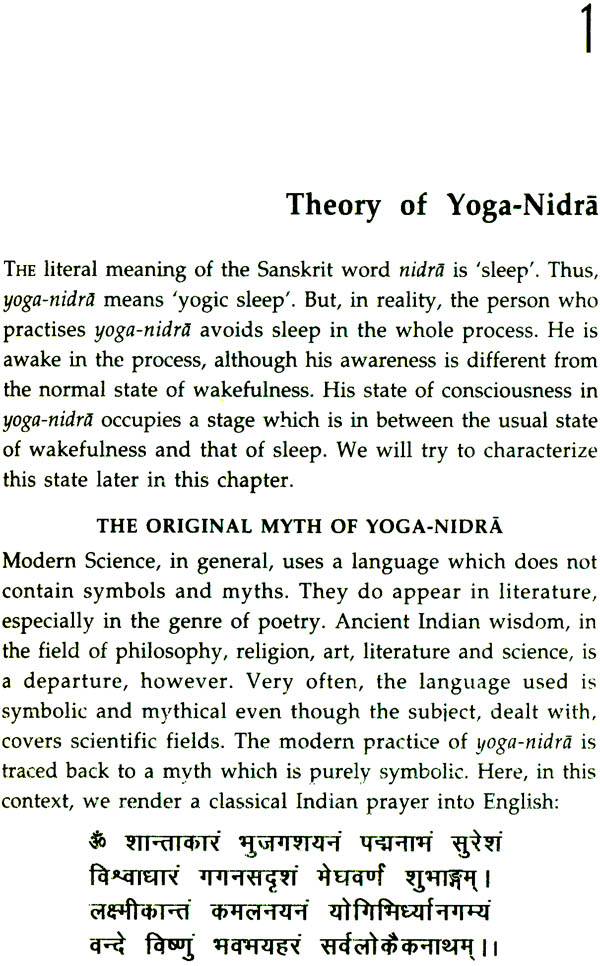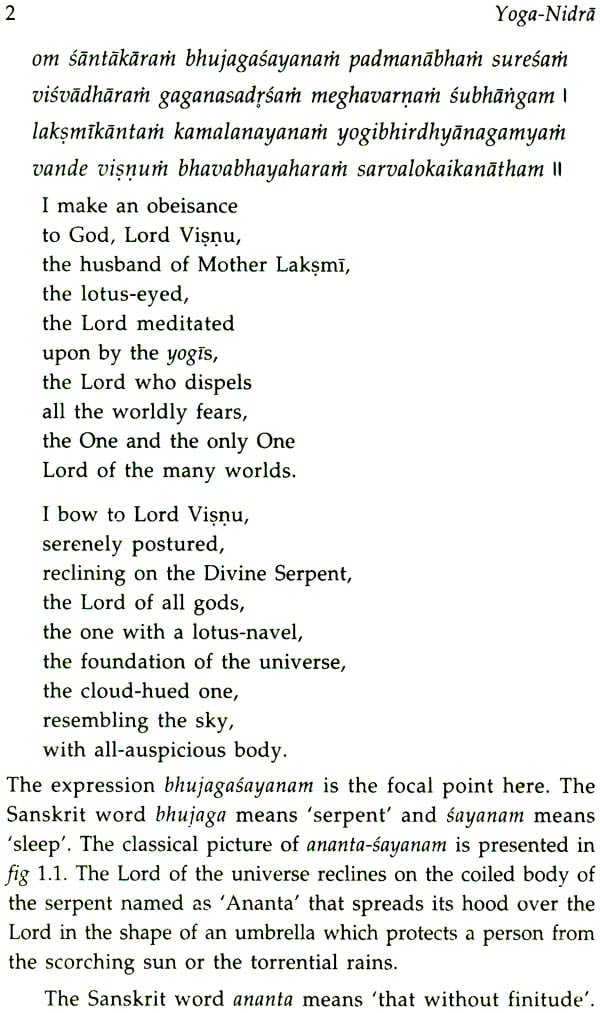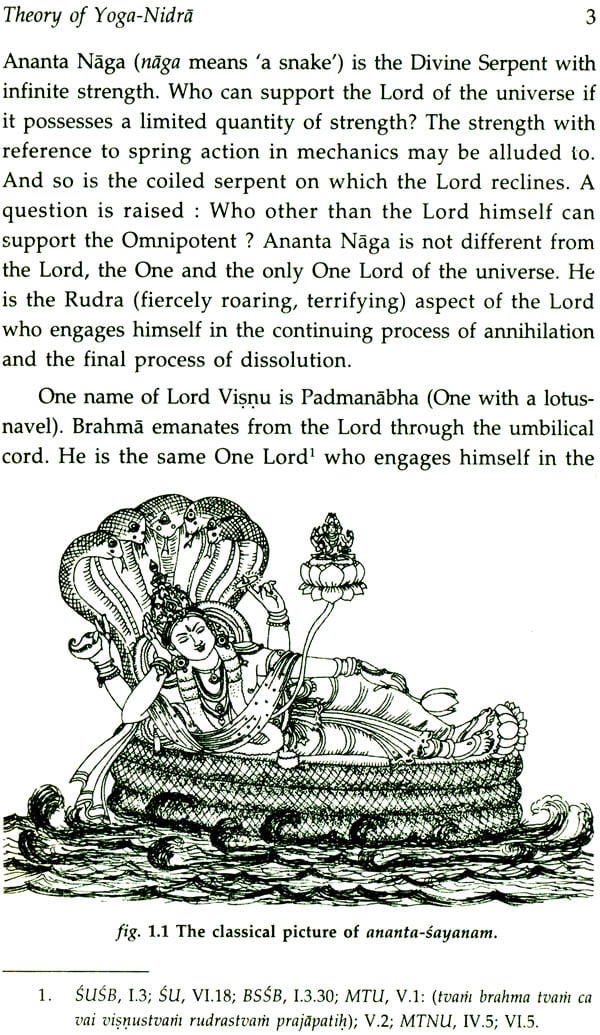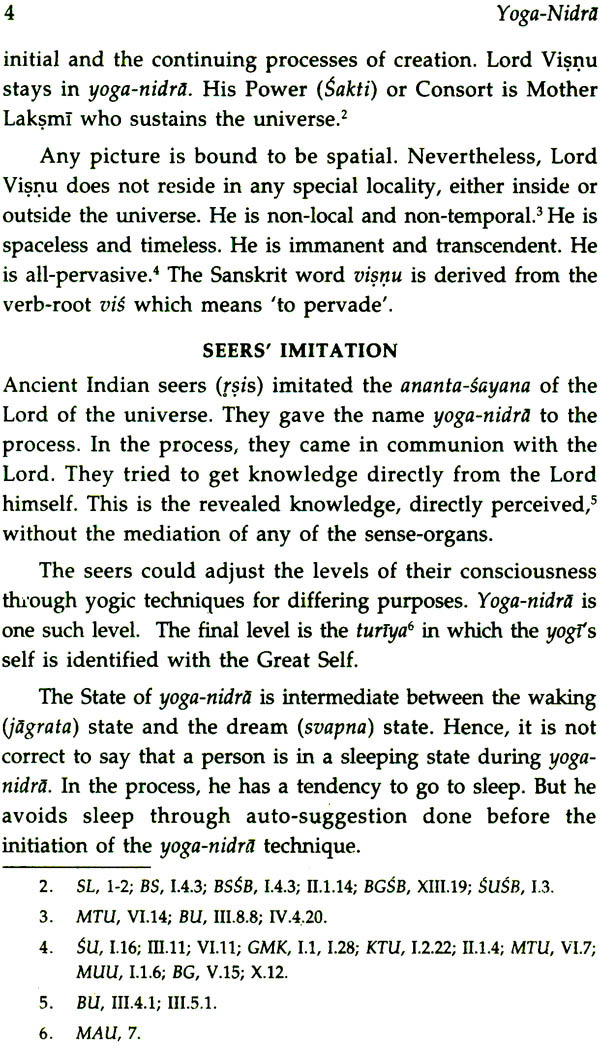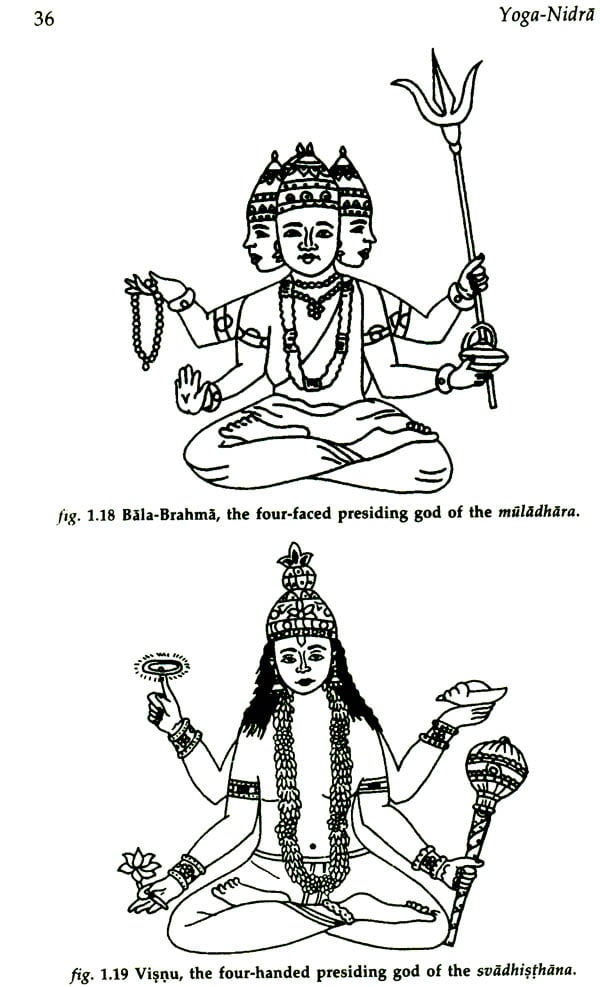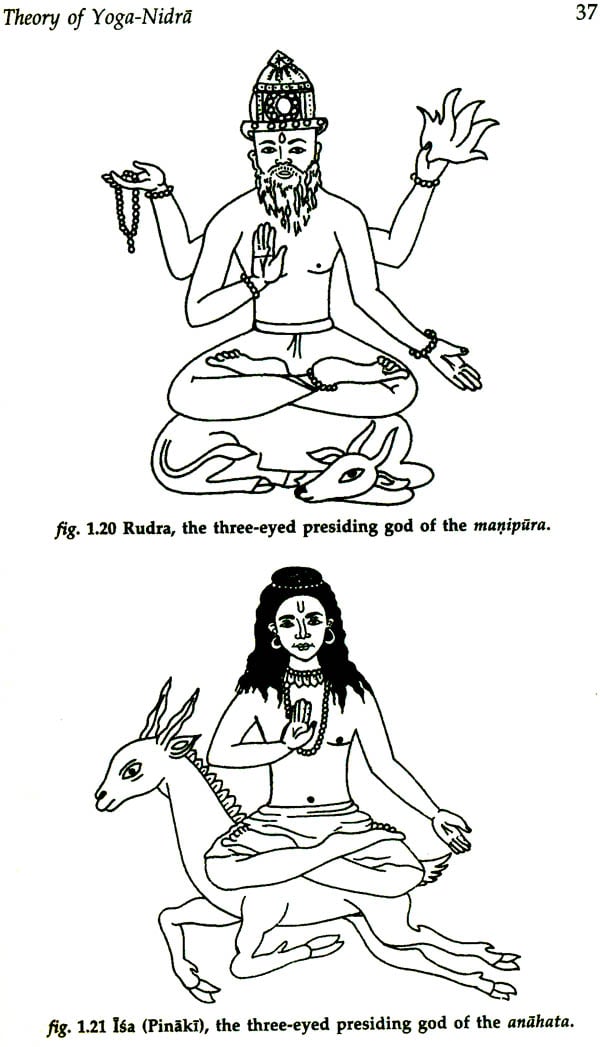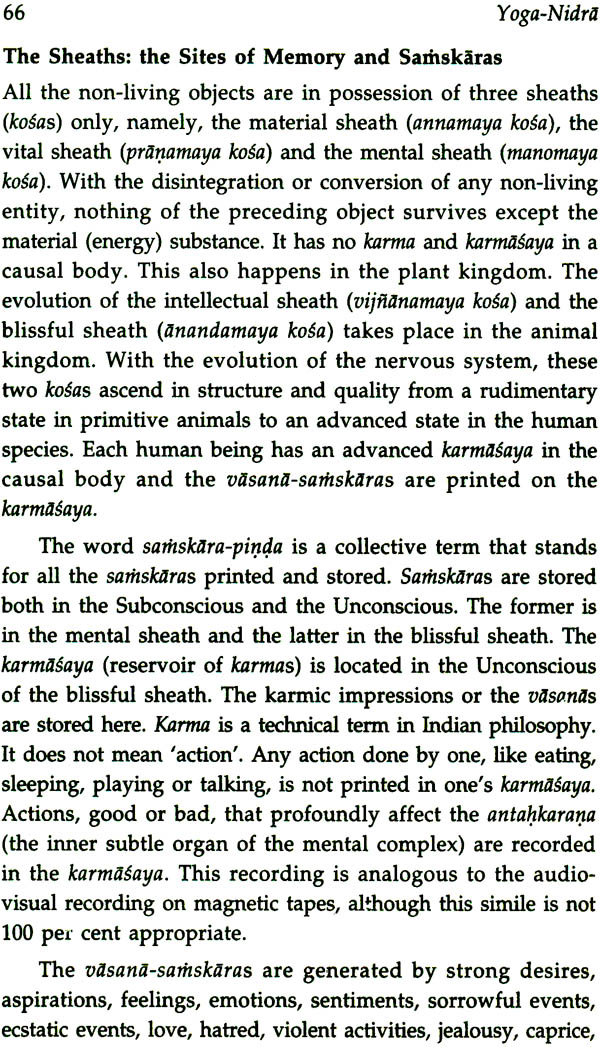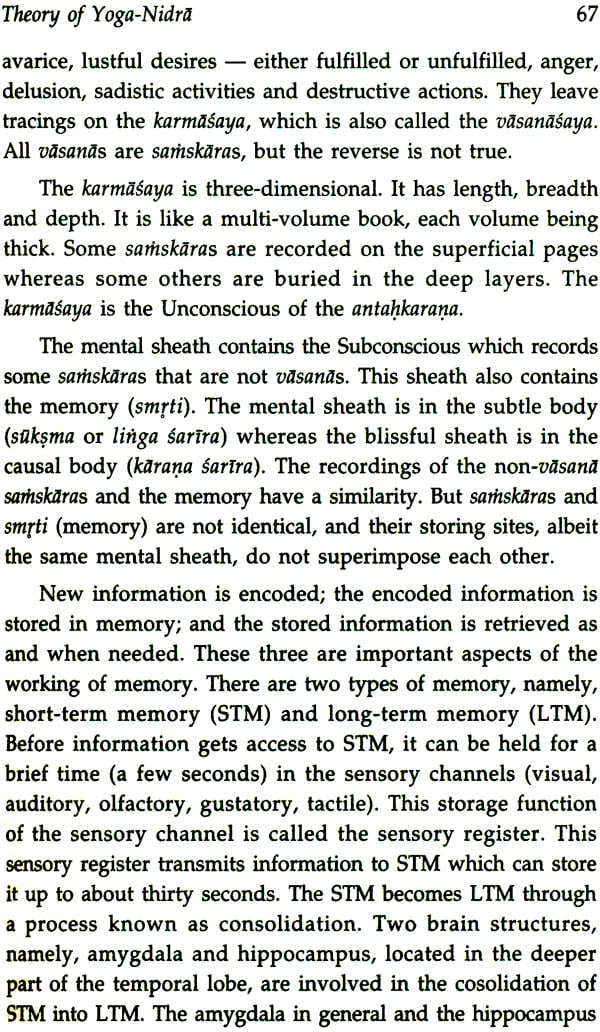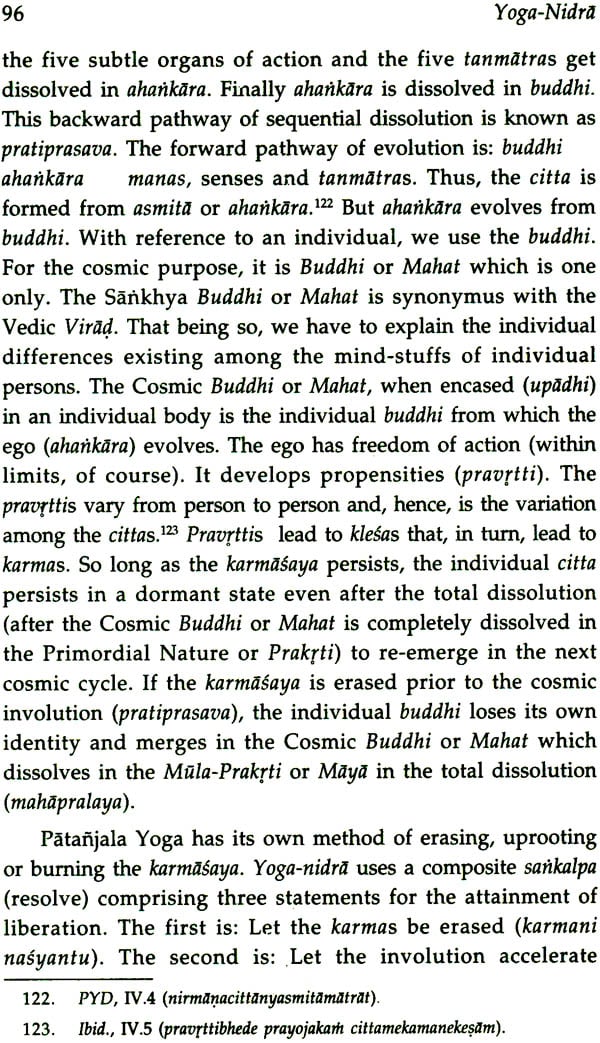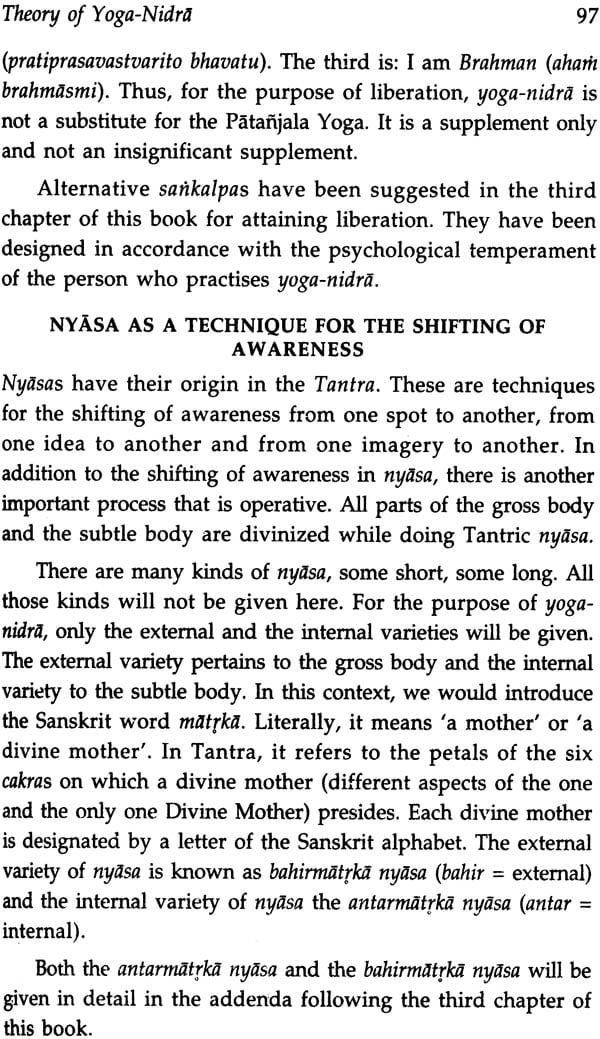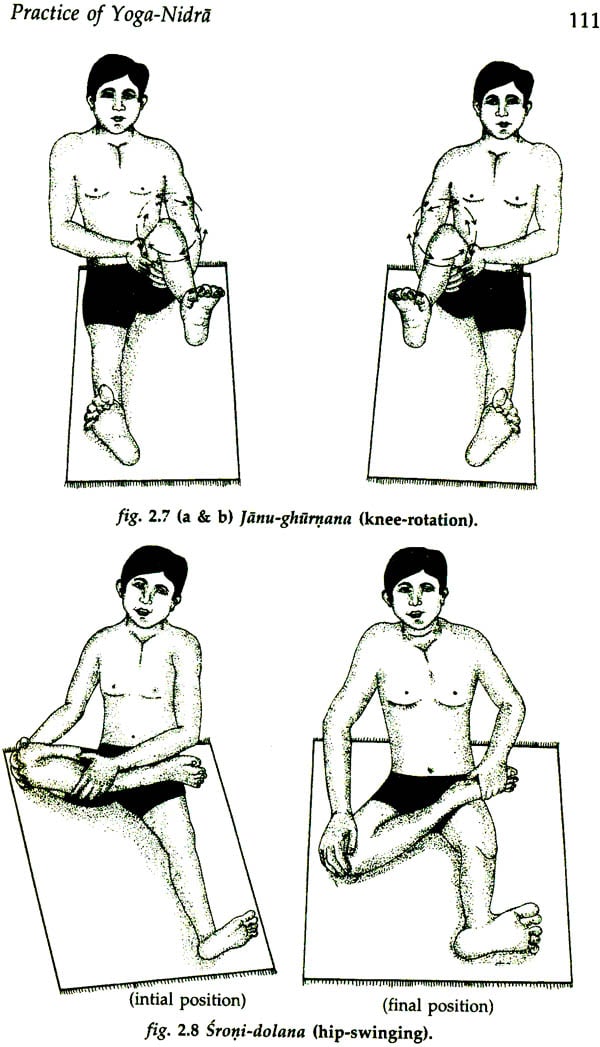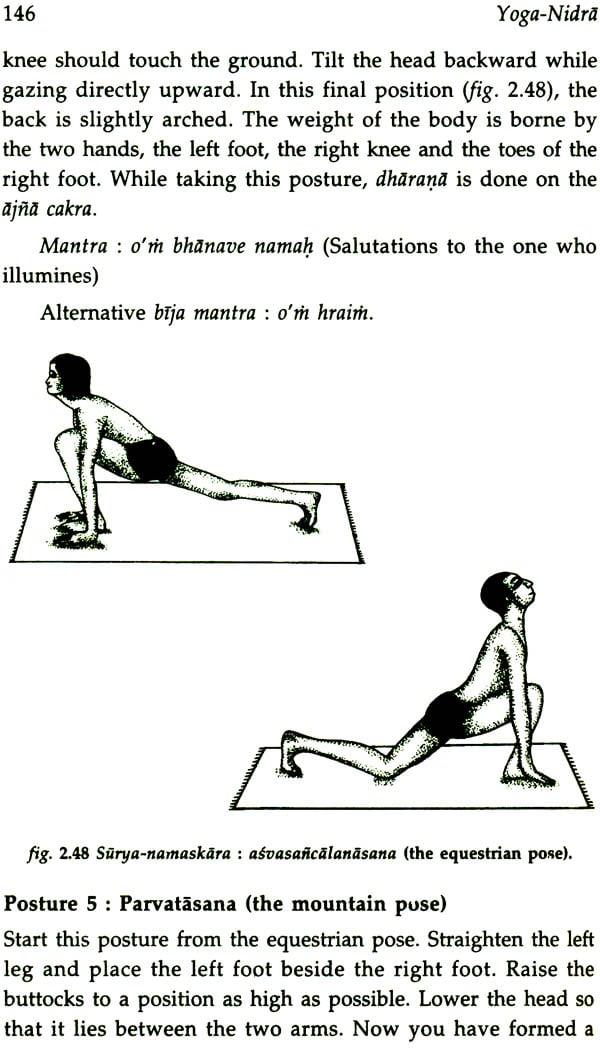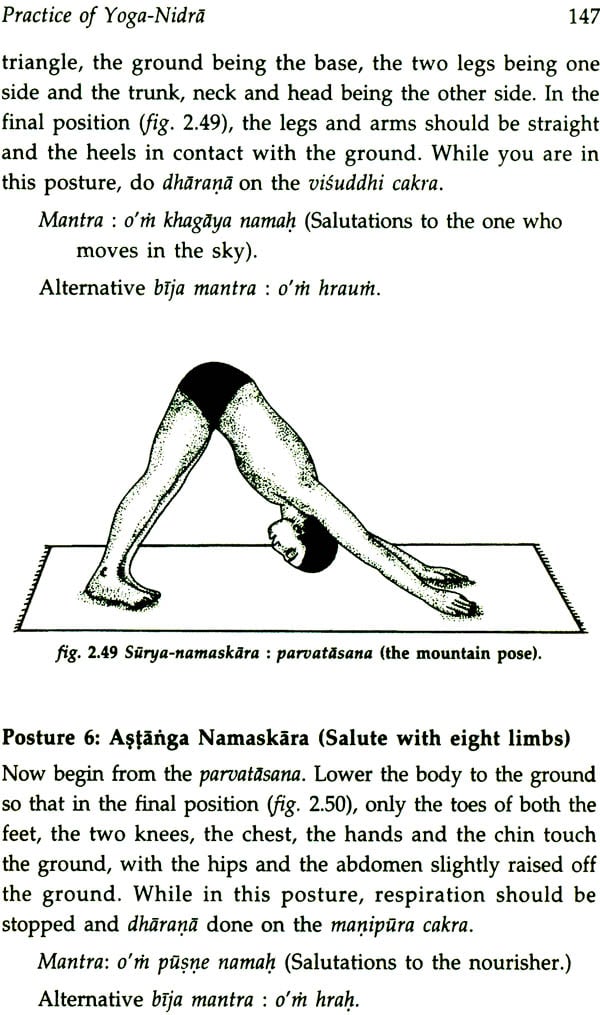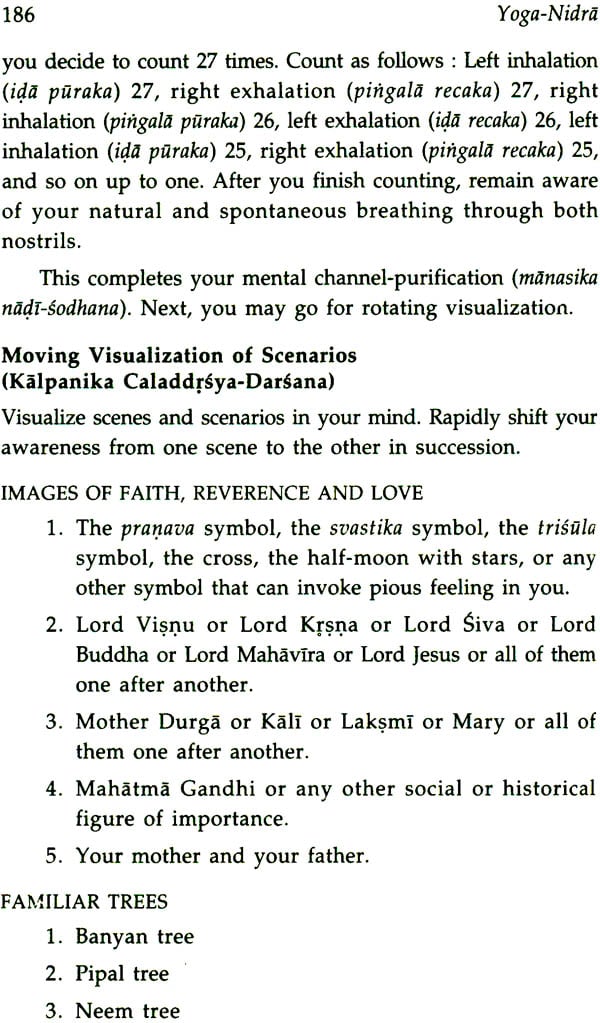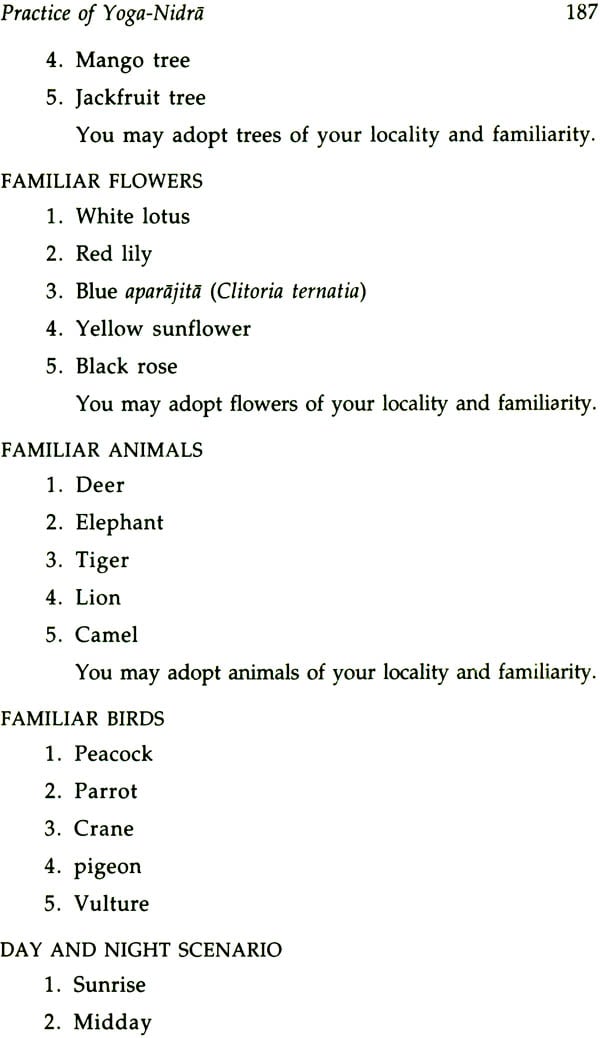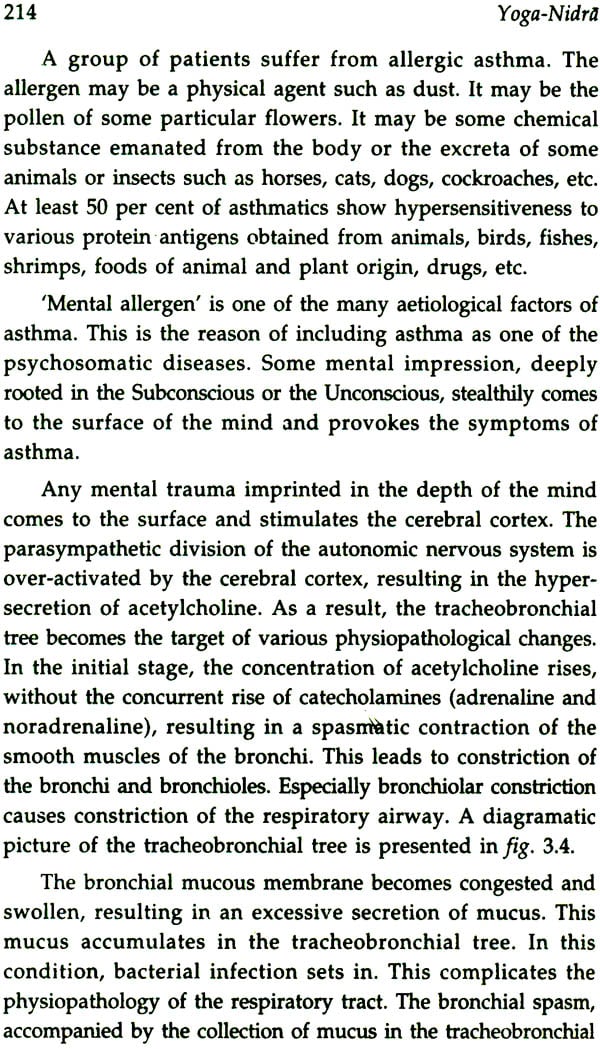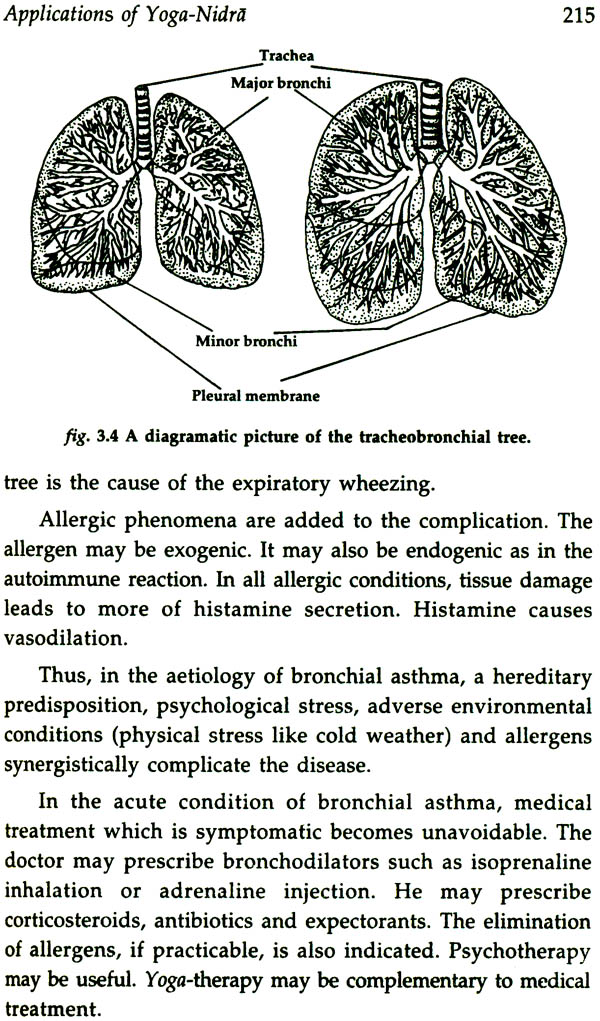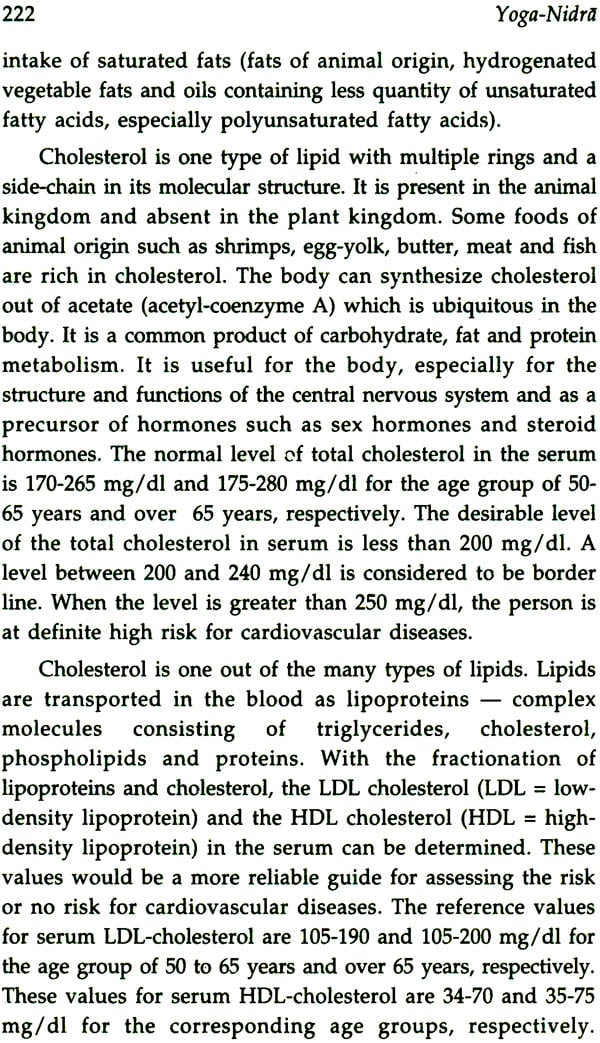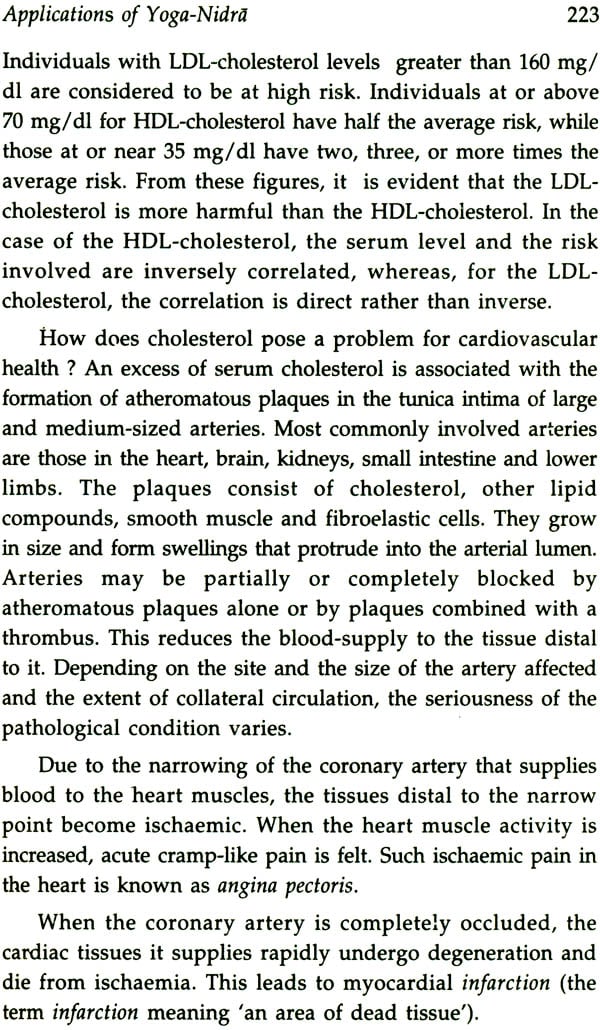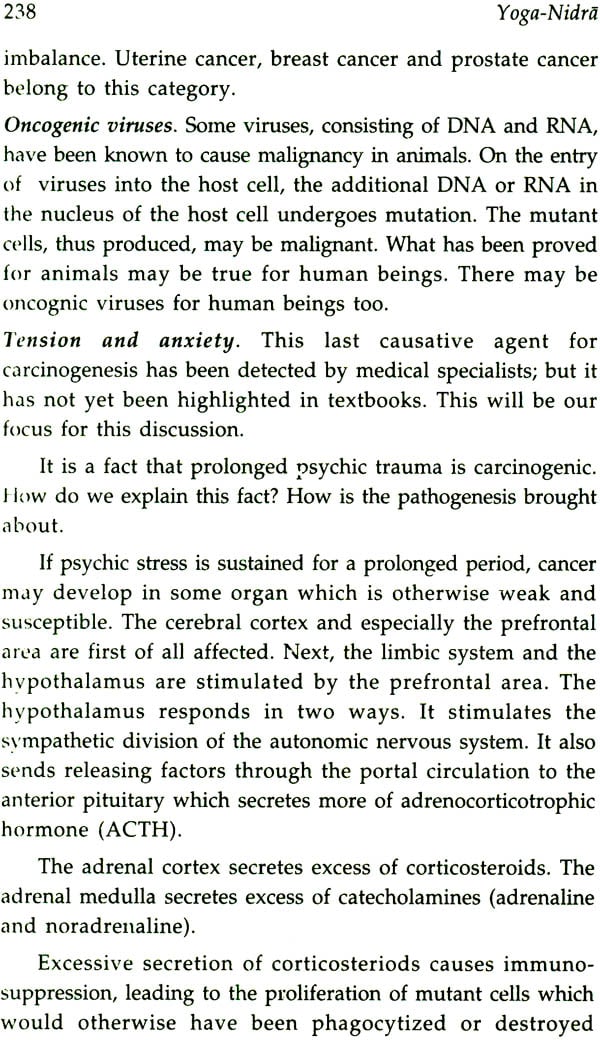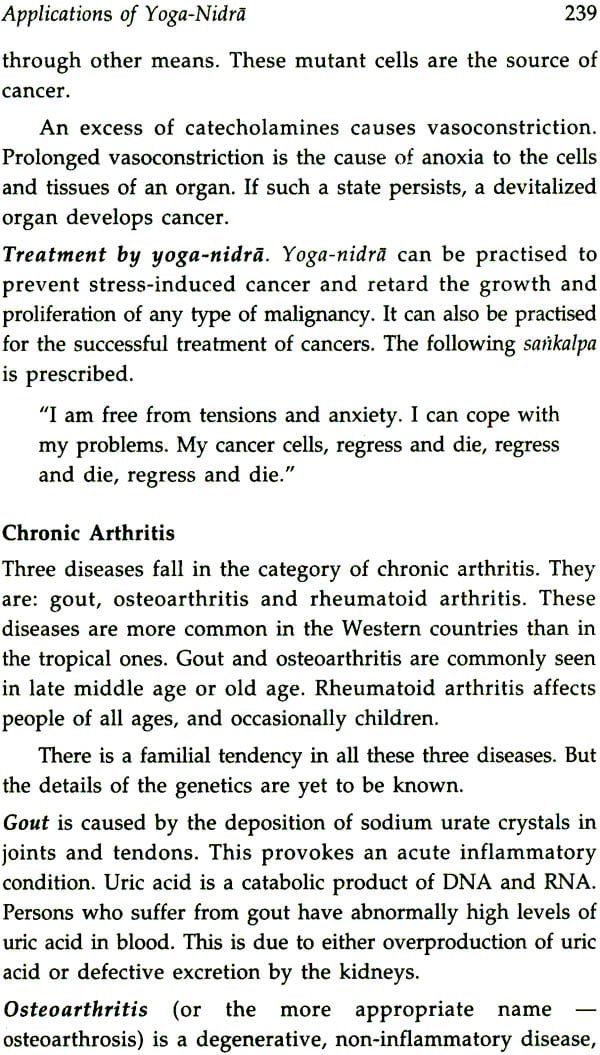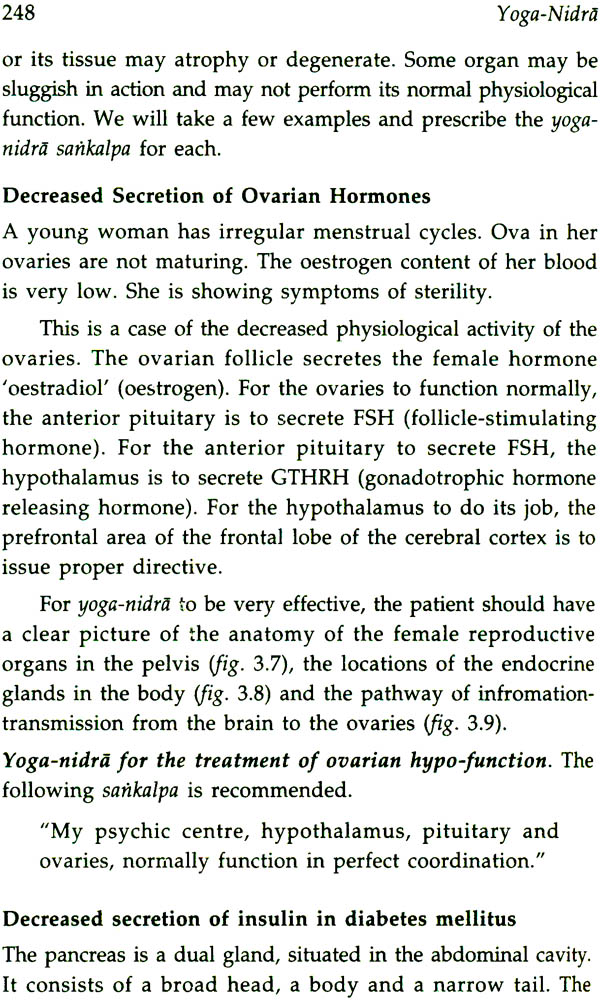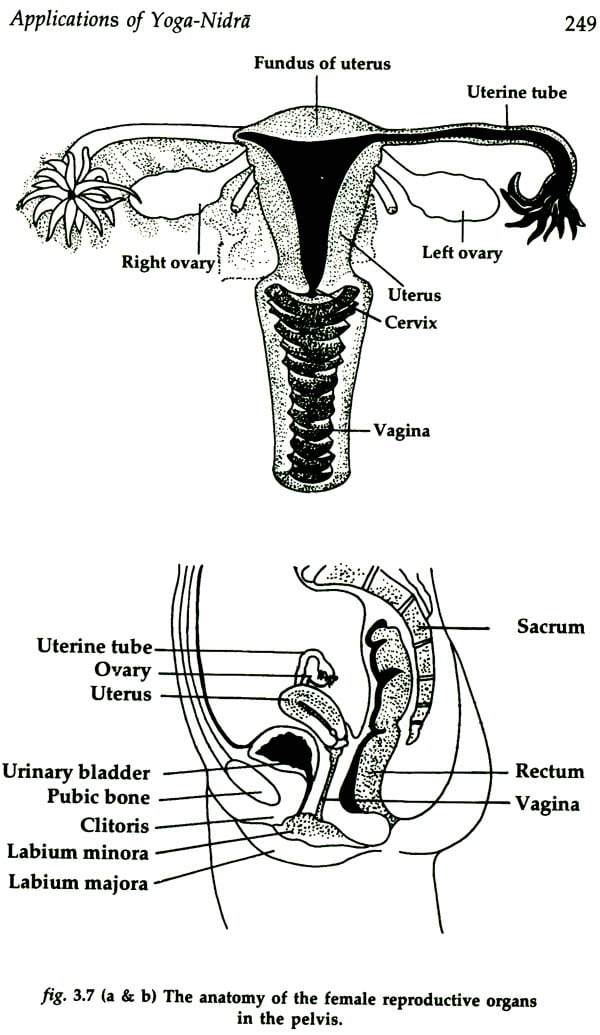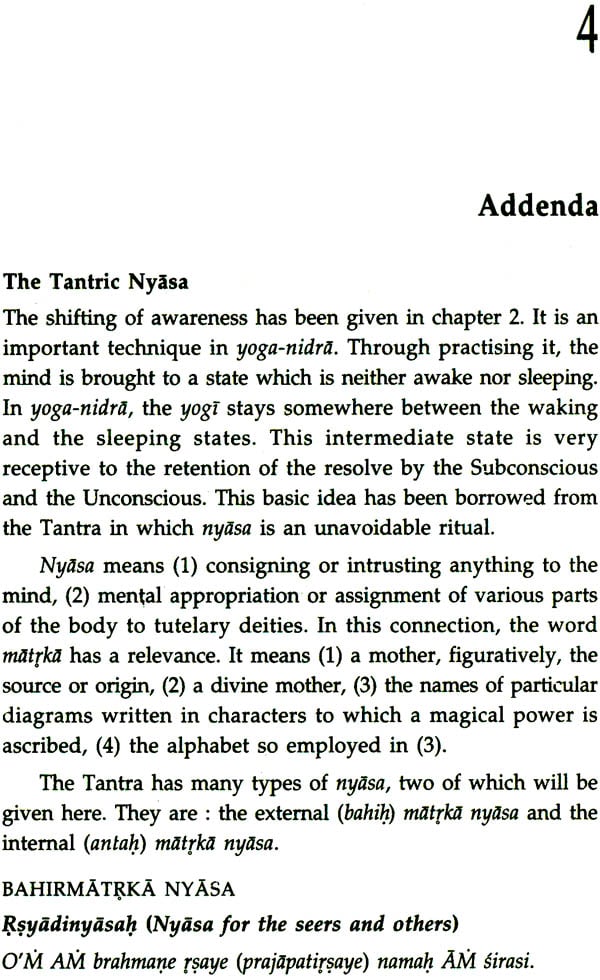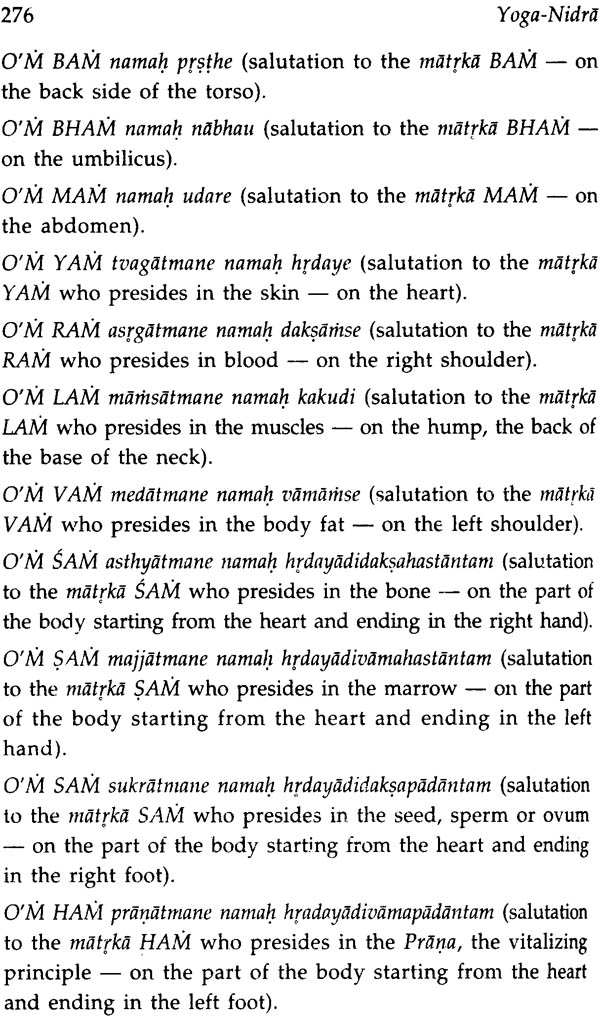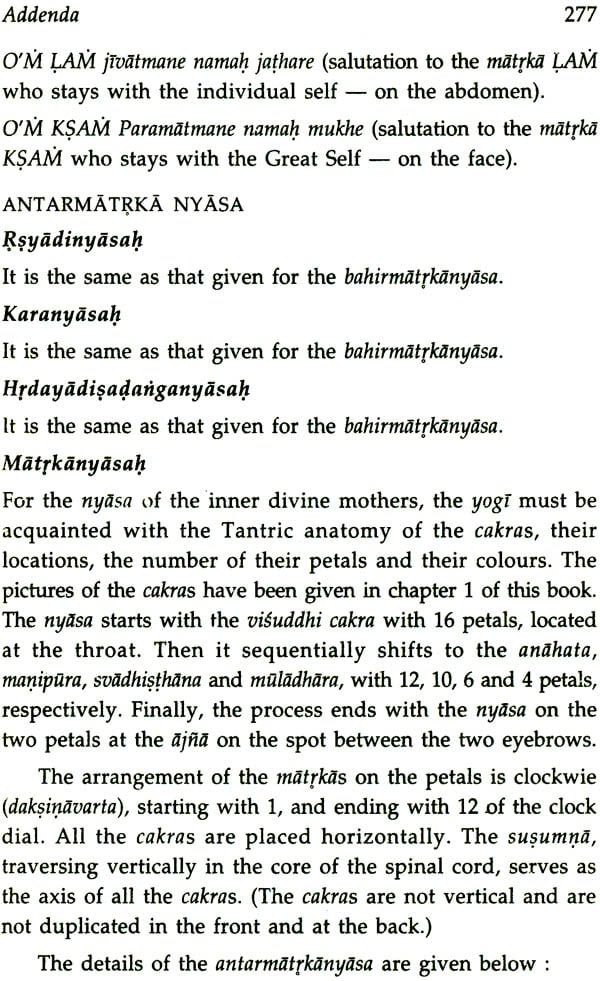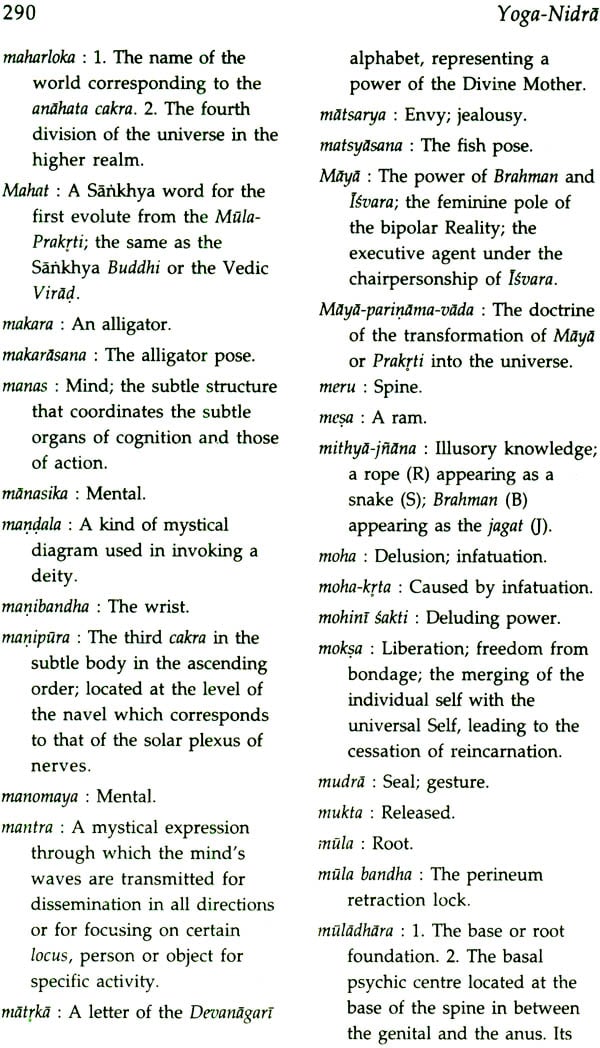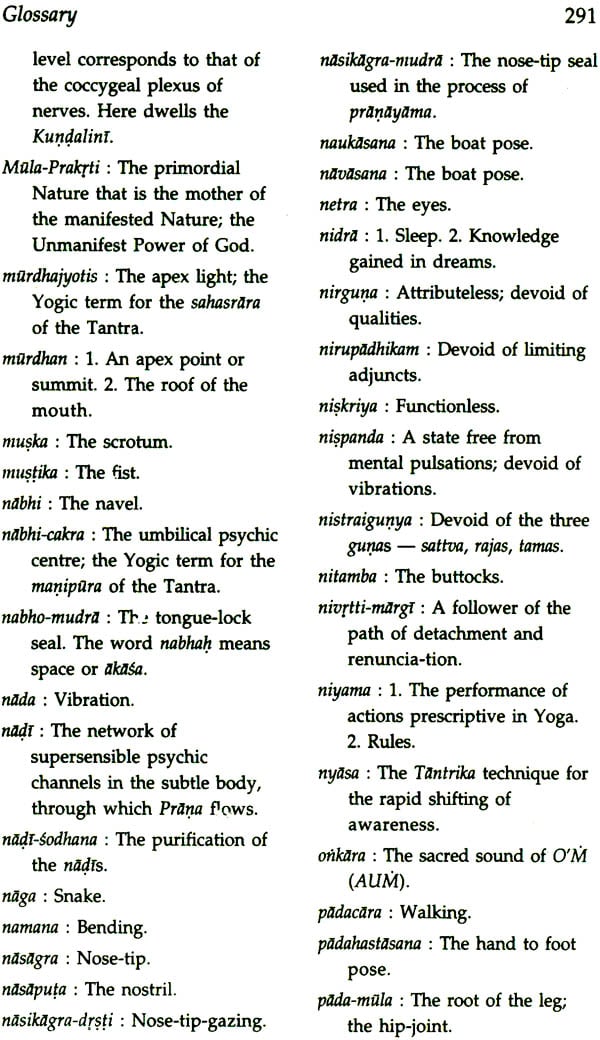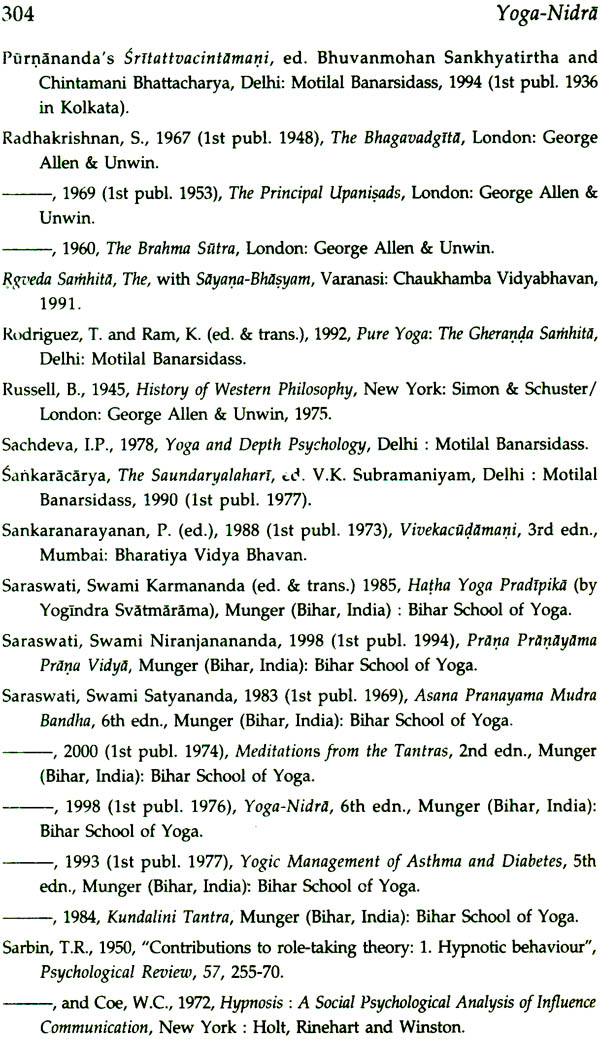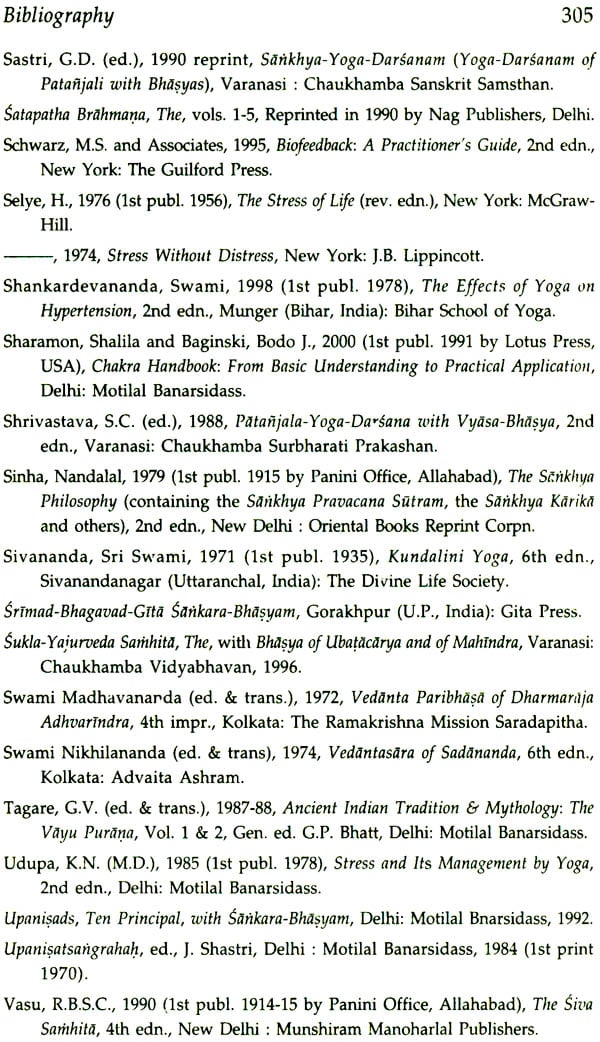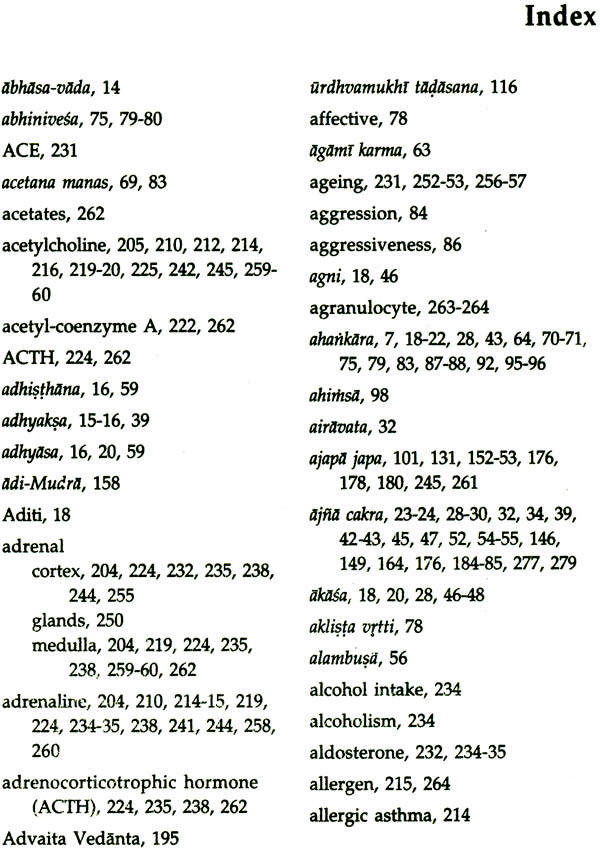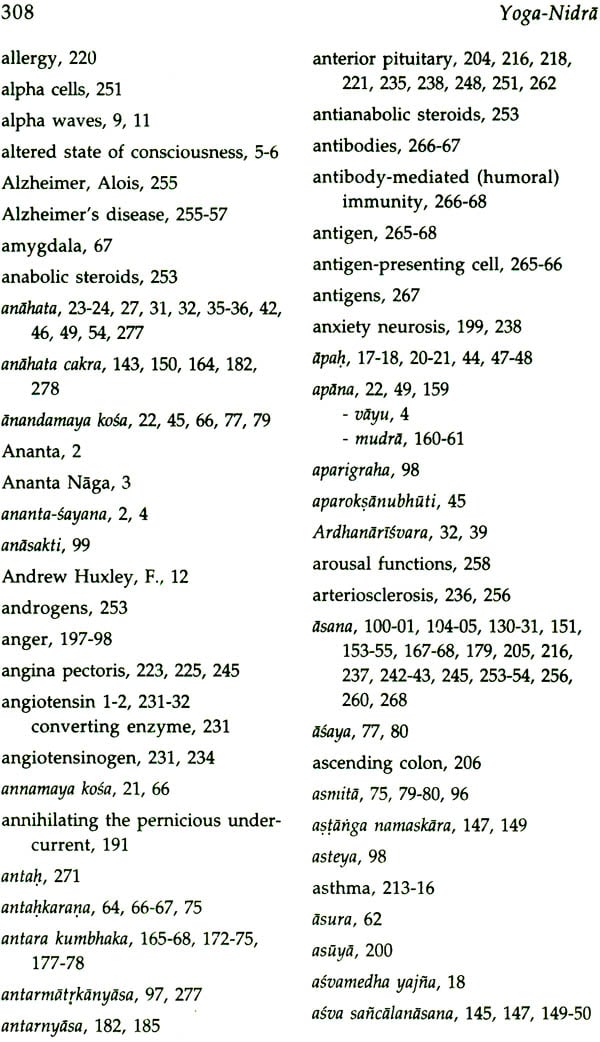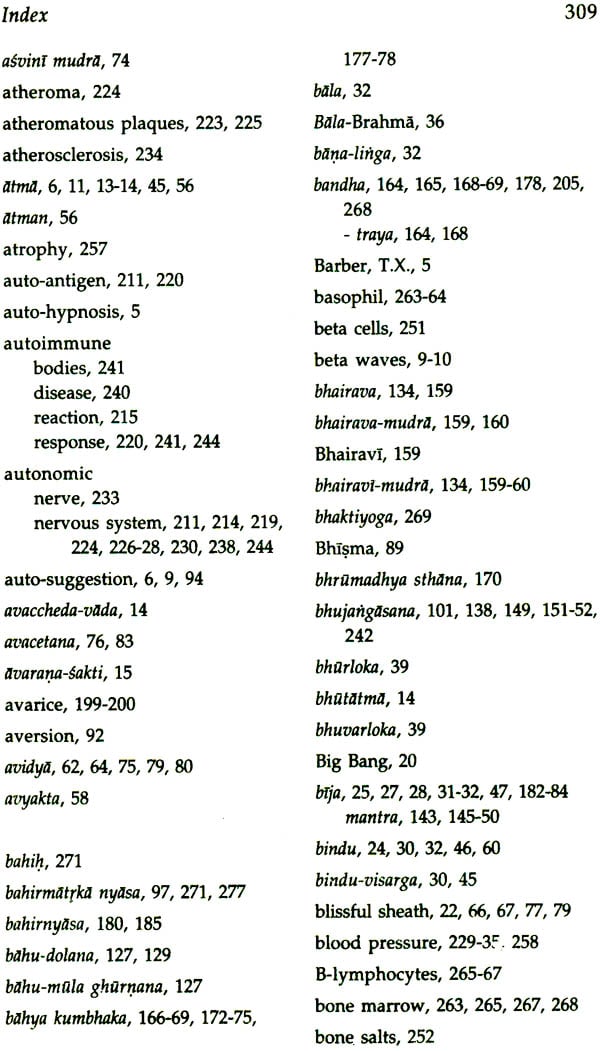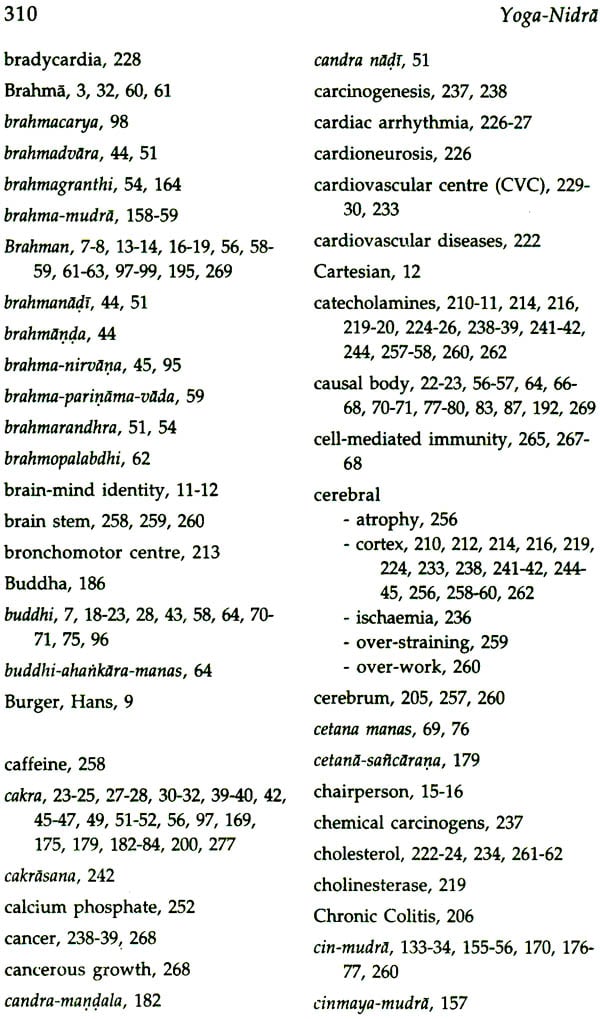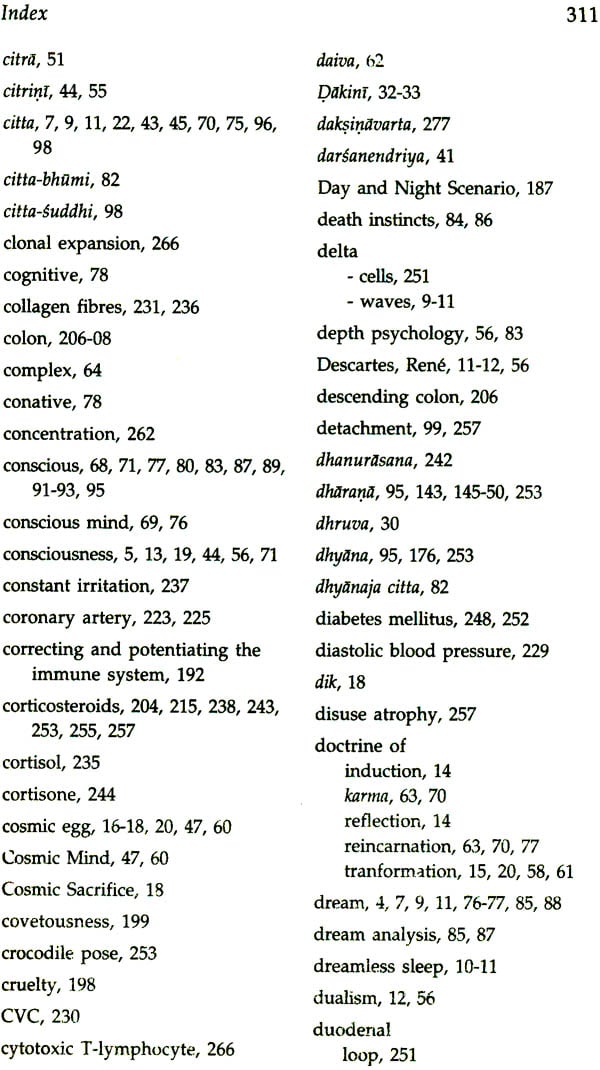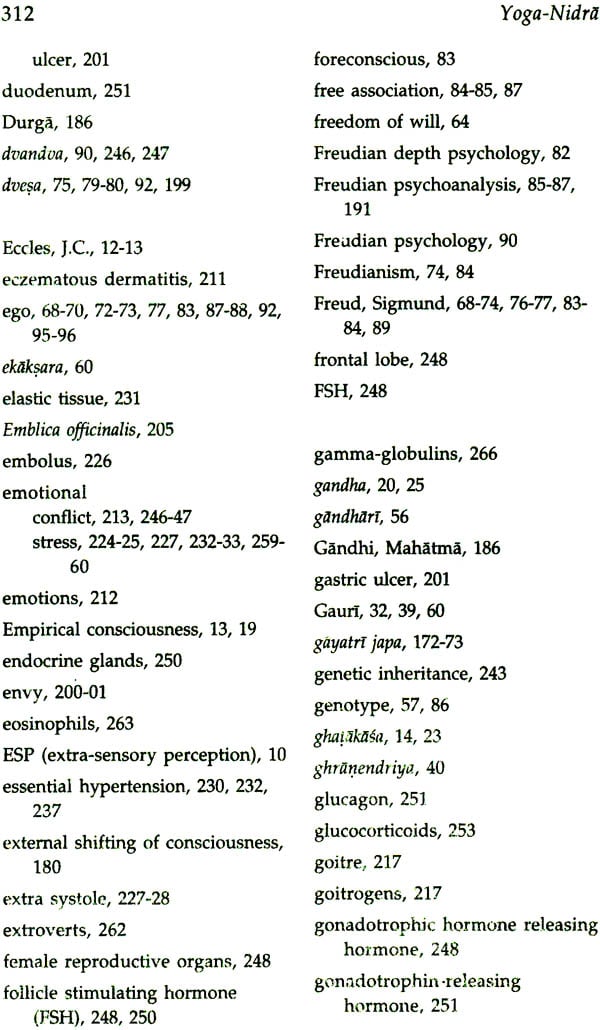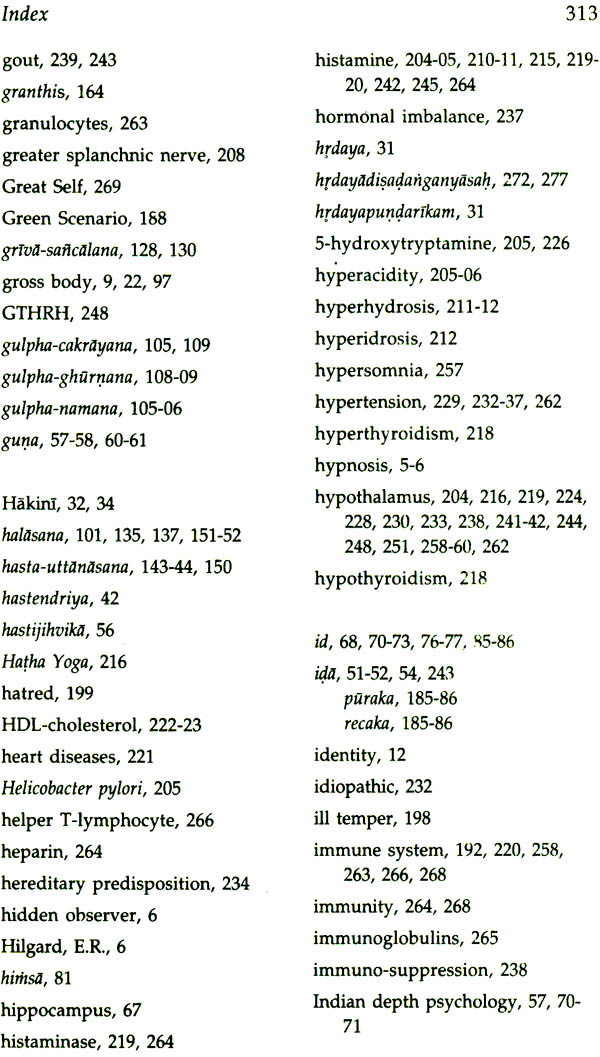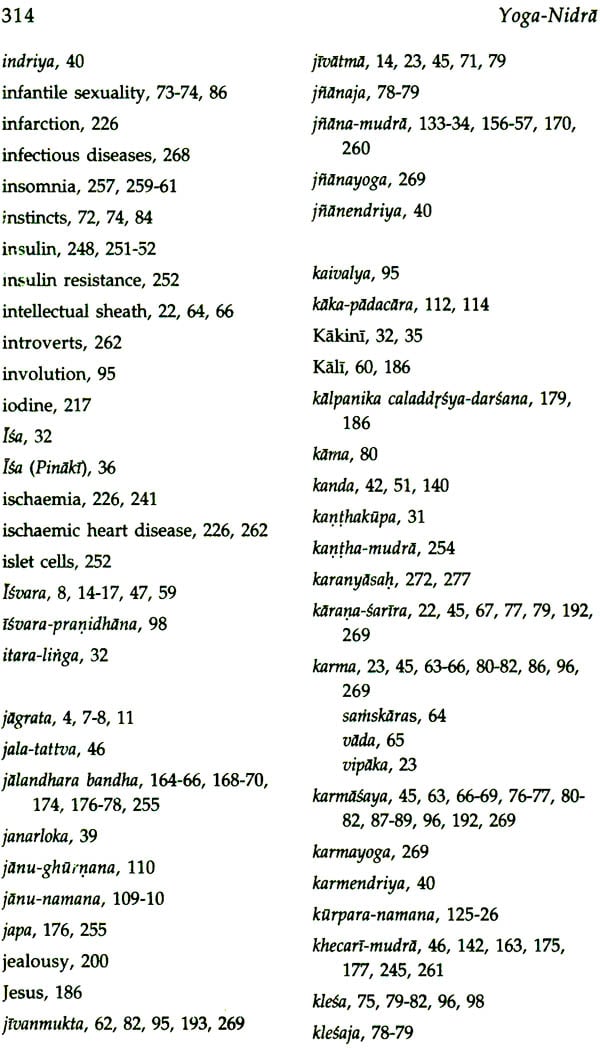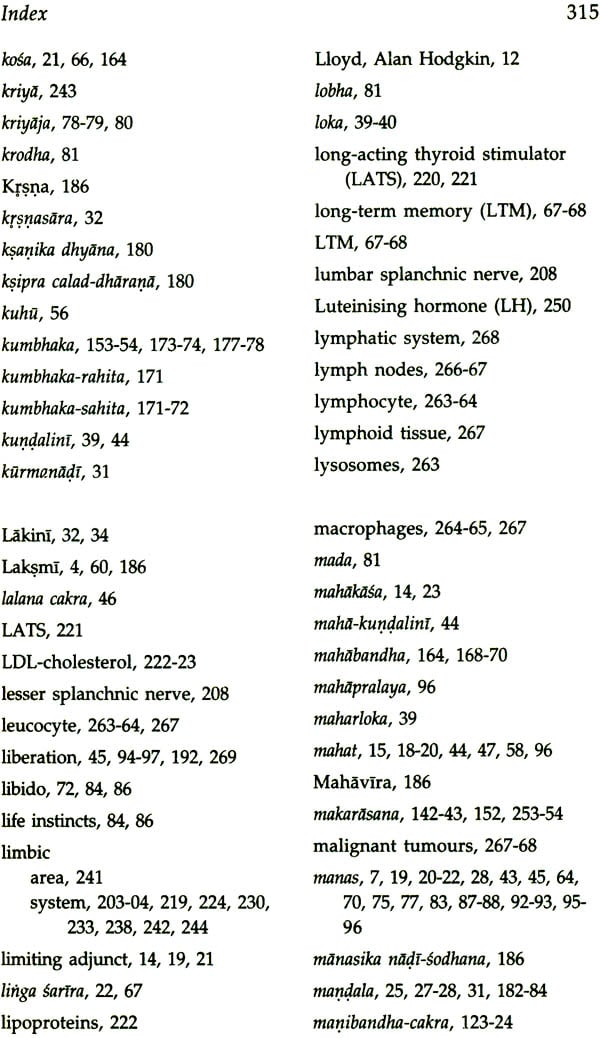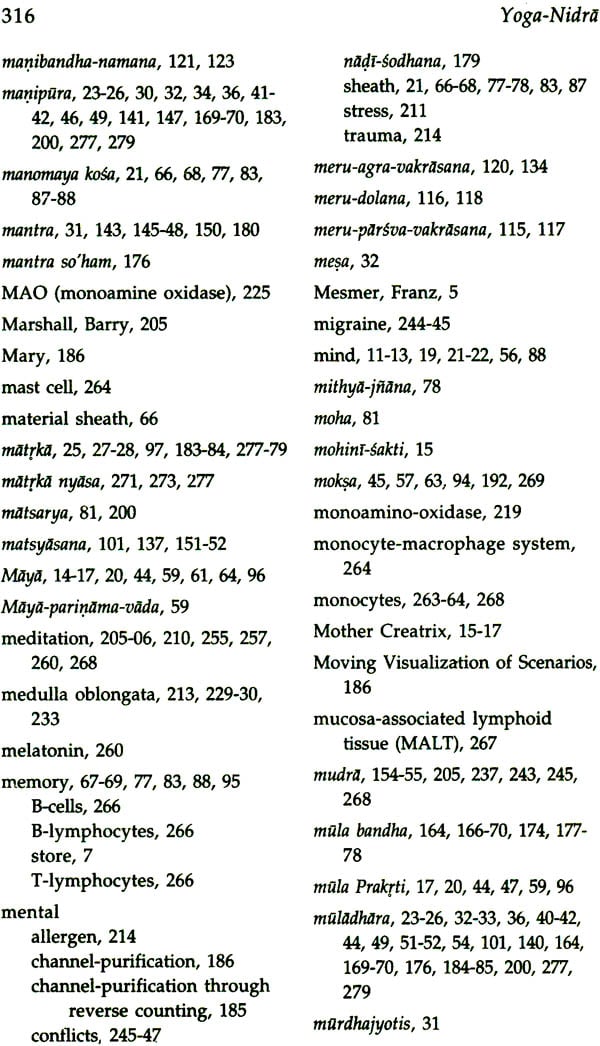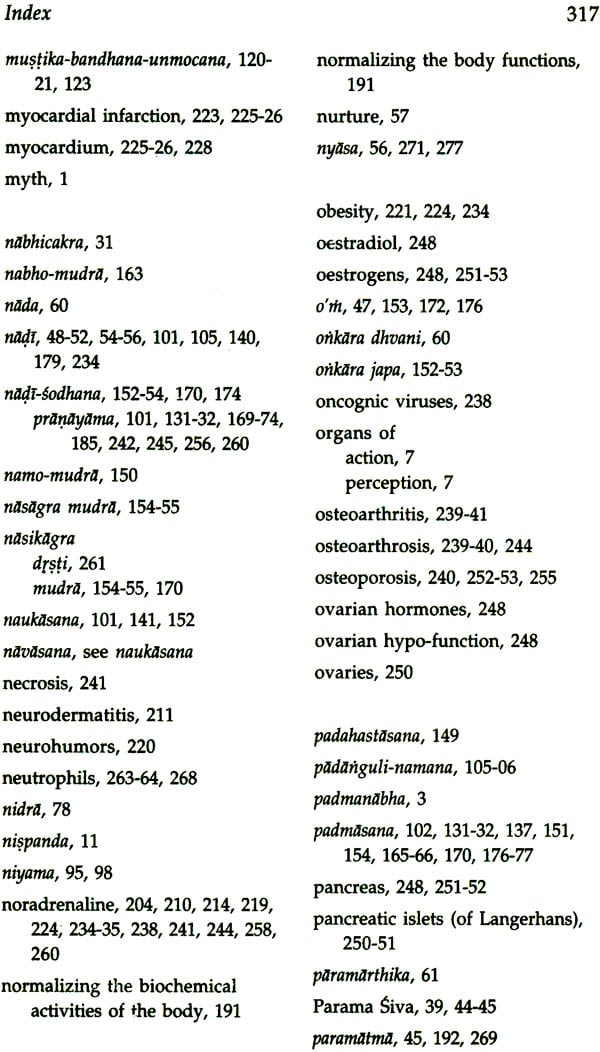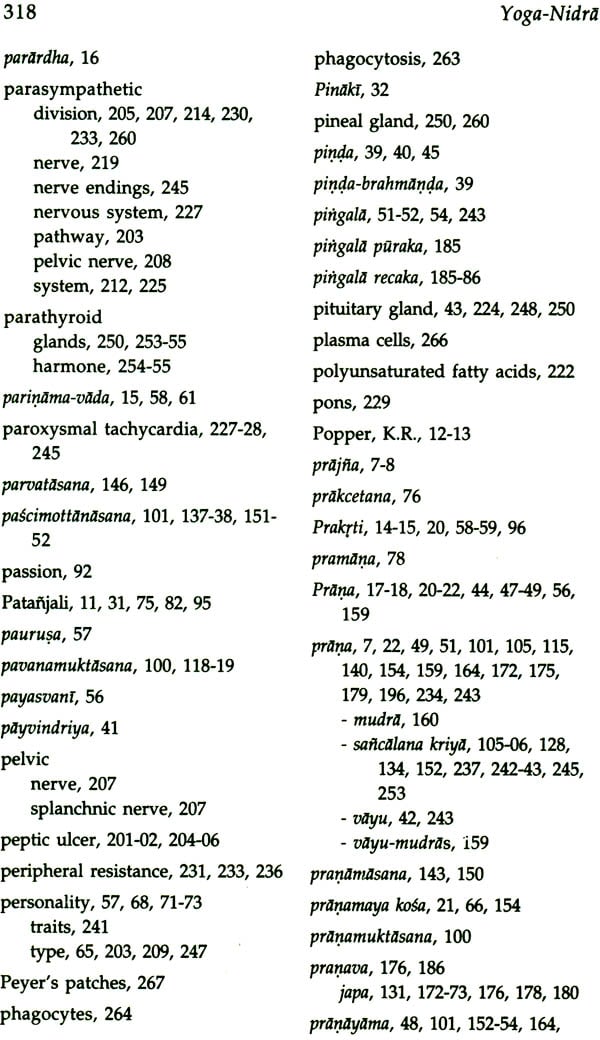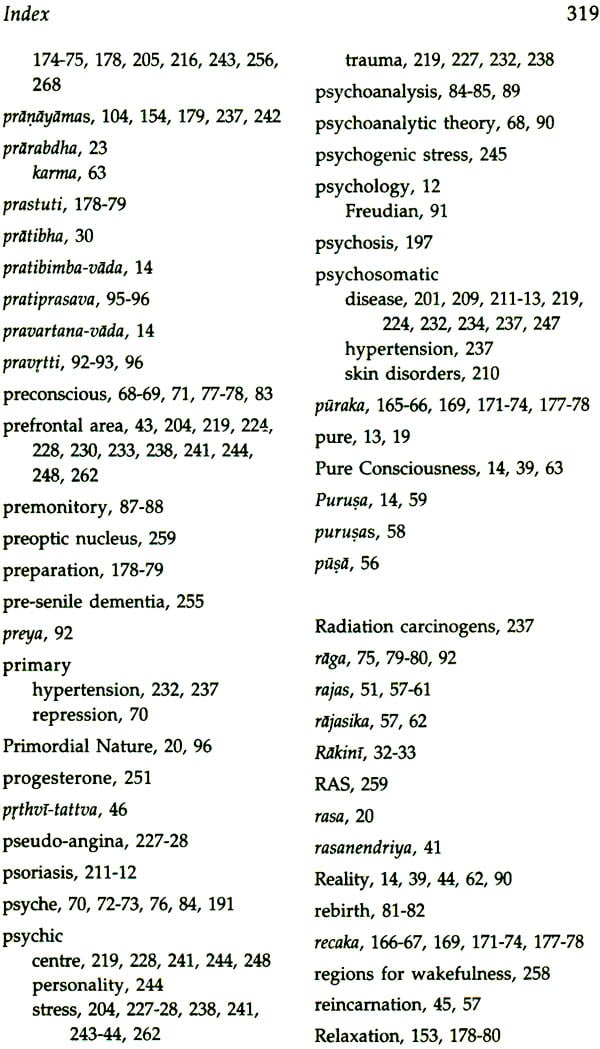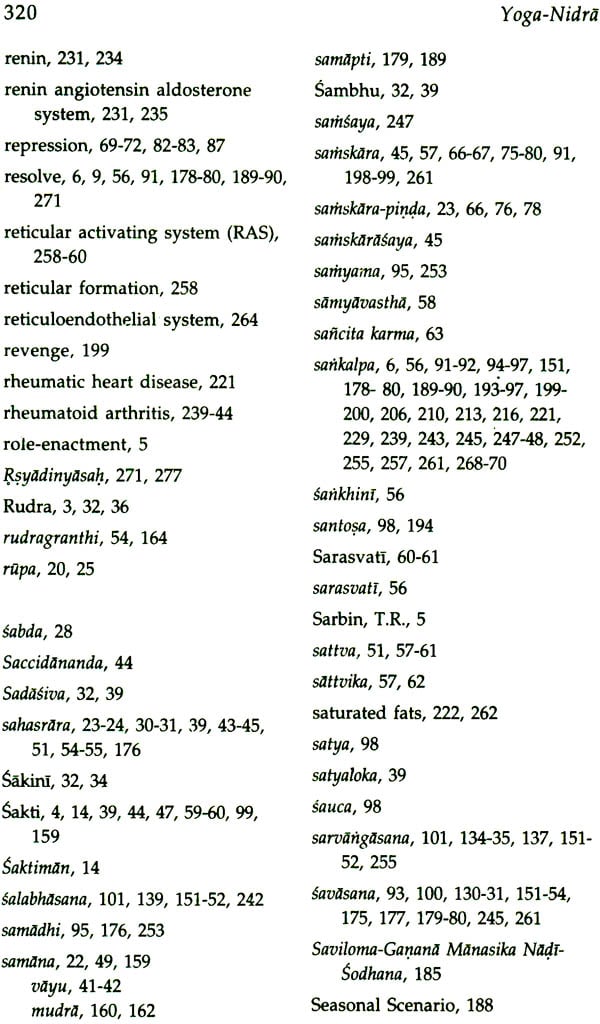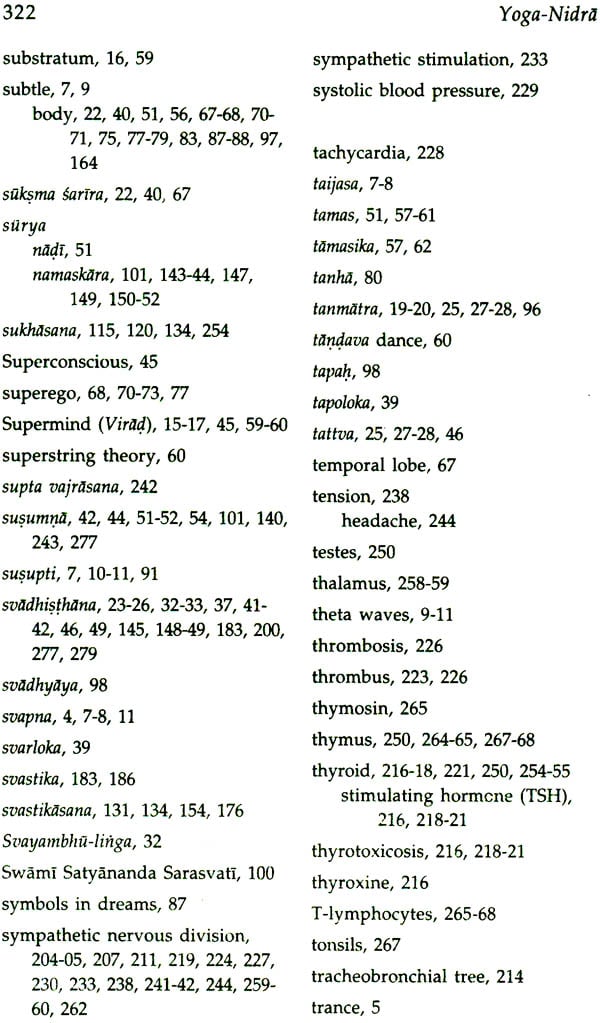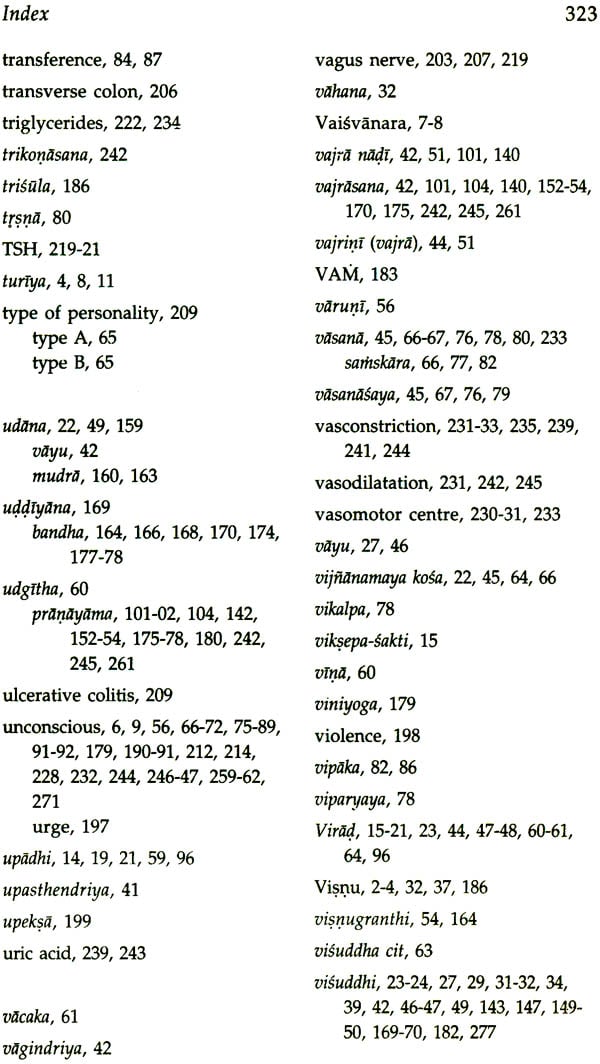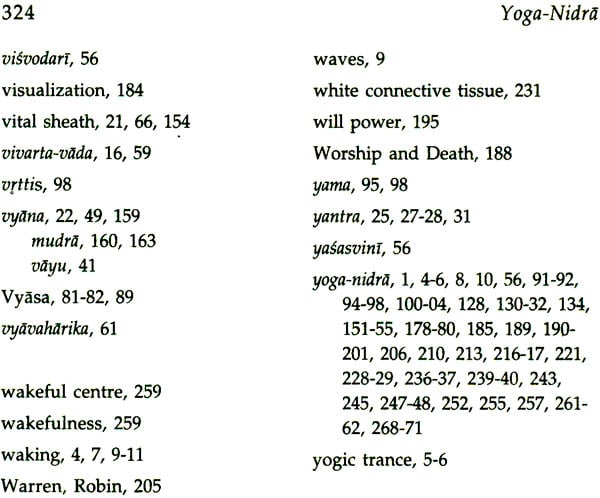
Yoga-Nidra (Yogic Trance Theory, Practice and Applications)
Book Specification
| Item Code: | IDE080 |
| Author: | N.C. Panda |
| Publisher: | D. K. Printworld Pvt. Ltd. |
| Language: | English |
| Edition: | 2022 |
| ISBN: | 9788124602430 |
| Pages: | 352 (B & W Figures: 116) |
| Cover: | Paperback |
| Other Details | 8.5" X 5.5" |
| Weight | 360 gm |
Book Description
Prologue
When we think of good health, we very often refer to the body, and we rarely ascribe good or bad health to a healthy or unhealthy mind. The interaction of the body and the mind has been recognized by the Indian seers since time immemorial. Of course, this was not the case with Rene Descartes (1596-1650), the French rationalist and dualist who is regarded as the founder of modern western philosophy and psychology. Inn the Cartesian psychology, the body and the mind could not directly interact. This concept of Descartes has already been discarded by modern Western psychology. It has already been recognized throughout the world that the practice of yoga makes the mind calm, tranquil and healthy. For an average person, it is often difficult to control the mind. For a yogi, however, it is practicable to restrain the mind. Yoga-nidra, being a technique of Yoga and Tantra, is an effective means of controlling and regulating the mind.
A number of diseases are psychosomatic. They are rooted in the psyche (mind), but they blossom and bear fruits in the physique (body). Medical and surgical treatments of psychosomatic diseases do help the patients, but cannot uproot the original cause. Psychoanalysis and psychotherapy sometimes alleviate the symptoms, but not always. Psychoanalysis has its own limitations. The subjectivity of the analyst, the patient's cooperation and his limitations are some of the factors that act as constraints. Moreover, psychotherapy involves a psychology-specialist who is to diagnose the disease and treat the patient. On the other hand, yoga-nidra is a self-therapy and its does not involve analysis.
There are many diseases which are due to physiological malfunction or dysfunction. Some are due to biochemical malfunction or dysfunction. Both the physiological and biochemical abnormalities can be corrected by resolves in yoganidra. The resolve is retained by the deeper strata of the mind which, in turn, influences the appropriate portion of the brain that directs the relevant organ neurally through transmission of nerve-impulses ad hormonally through the pituitary gland which influences the other endocrine glands.
A number of diseases are primarily caused by mental trauma and anxiety. Some of them are very serious and sometimes even fatal. Cardiac diseases and cancer are examples of this category. Yoga-nidra may be practiced to reduce or to get rid of tension and prevent and cure diseases caused by tension.
Yoga-nidra is a potent tool to fortify the immune system of the body. Thereby many diseases can be prevented and cured.
In addition to the prevention and treatment of diseases, yoga-nidra can be used to improve one's personality, to regulate one's habits and life-patterns, to get rid of some unwanted indulgence and addictions and to improve the quality of life.
Yoga-nidra can be used for spiritual uplift too. Spiritual uplift can be graded and gradual, leading finally to liberation (moksa).
In this book, hypnosis and yoga-nidra have been compared and contrasted. The resolve (sankalpa) is a suggestion and auto-suggestion. If considered on this point, both have a commonality. Except this, the two are different. The hypnotic state is an altered state of consciousness whereas the yoganidra state is intermediate between the conscious state and the sleeping state. Hypnotic auto-suggestion being excluded, hypnosis involves a hypnotist who directs the subject. On the other hand, the resolve in yoga-nidra is an auto-suggestion and auto-therapy which does not involve a second person. In the yoga-nidra concept, the yogi induces a receptive state (half awake and half asleep, but still conscious) in which the Subconscious and the Unconscious receive and record the resolve for future action. They later influence the relevant organ through the brain favourably. They also influence the conscious mind.
The Indian concept of the separateness of the brain and the mind and the concept of the brain being the apparatus of the mind have been emphasized in this book. Freudian depth psychology and Indian depth psychology have been compared and contrasted. This is the first book of its kind to present a critical analysis of Freudian depth psychology and to elaborate the tenets of Indian depth psychology. This is also the first book to explain the benefits of yoga-nidra in the context of Indian depth psychology and in the modern format of medical physiology, biochemistry and pathology.
Swami Satyananda Sarasvati of the Bihar School of Yoga has popularized yoga-nidra. He and his associates have written some books on this topic. The present book is not a duplicate of what they have written. Academic depth psychology is elaborately treated in this book. The applications of yoga-nidra, with special reference to medical science, have been scientifically presented. Furthermore, the techniques of yoga-nidra have been well systematized and standardized. For the first time, yoga-nidra has been assigned a scientific status in this book.
This book comprises four chapters. The first chapter presents a theoretical background of yoga-nidra and a theoretical background of Indian depth psychology vis-à-vis Freudian depth psychology. The Indian concept of mind has been presented lucidly for the first time. The second chapter gives the techniques of yoga-nidra in a lucid, simplified manner. The third chapter deals with the applications of yoga-nidra. Some of the applications, with special reference to diseases, have been somewhat technical. The discussions relate to medical science. Practising doctors, throughout the world, would perhaps consider the topic unbiasedly and objectively. It is expected that this book would serve as a standard reference work for the use of yoga-nidra in medical practice.
The fourth chapter of this book is an addenda. A typical system of Tantric nyasa has been given here. It would not be possible to induce the yoga-nidra state without doing nyasa. Hence it has a tremendous significance in the total process of yoga-nidra.
Modern age, with technological civilization, over-ambition, rat-race for competition and alienation, is overburdened with tension, anxiety and frustration. It is hoped that the modern man would benefit much by practicing yoga-nidra. And this is expected to serve as a useful handbook.
It is a multi-disciplinary book dealing with Yoga, Tantra psychology and medical science. The attempt of the writer is introductory. If the introduction serves as a catalyst to accelerate further generation of higher thought, it would benefit humankind for the attainment of physical, mental and spiritual health.
Theory of Yoga-Nidra
The literal meaning of the Sanskrit word nidra is 'sleep'. Thus, yoga-nidra means 'yogic sleep'. But, in reality, the person who practices yoga-nidra avoids sleep in the whole process. He is awake in the process, although his awareness is different from the normal state of wakefulness. His state of consciousness in yoga-nidra occupies a stage which is in between the usual state of wakefulness and that of sleep. We will try to characterize this state later in this chapter.
THE ORIGINAL MYTH OF YOGA-NIDRA
Modern Science, in general, uses a language which does not contain symbols and myths. They do appear in literature, especially in the genre of poetry. Ancient Indian wisdom, in the field of philosophy, religion, art, literature and science, is a departure, however. Very often, the language used is symbolic and mythical even though the subject, dealt with, covers scientific fields. The modern practice of yoga-nidra is traced back to a myth which is purely symbolic. Here, in this context, we render a classical Indian prayer into English:
om santakaram bhujagasayanam padmanabham suresam visvadharam gaganasadrsam meghavarnam subhangam laksmikantam kamalanayanam yogibhirdhyanagamyam vande visnum bhavabhayaharam sarvalokaikanatham
I make an obeisance
to God, Lord Visnu,
the husband of Mother Laksmi,
the lotus-eyed,
the Lord meditated
upon by the yogis,
the Lord who dispels
all the worldly fears,
the One and the only One
Lord of the many worlds.
I bow to Lord Visnu,
serenely postured,
reclining on the divine Serpent,
the Lord of all gods,
the one with a lotus-navel,
the foundation of the universe,
the cloud-hued one,
resembling the sky,
with all-auspicious body.
The expression bhujagasayanam is the focal point here. The Sanskrit word bhujaga means 'serpent' and sayanam means 'sleep'. The classical picture of ananta-sayanam is presented in fig 1.1. The Lord of the universe reclines on the coiled body of the serpent named as 'Ananta' that spreads its hood over the Lord in the shape of an umbrella which protects a person from the scorching sun or the torrential rains.
The Sanskrit word ananta means 'that without finitude'. Ananta Naga (naga means 'a snake') is the Divine Serpent with infinite strength. Who can support the Lord of the universe if it possesses a limited quantity of strength? The strength with reference to spring action in mechanics may be alluded to. And so is the coiled serpent on which the Lord reclines. A question is raised: Who other than the Lord himself can support the Omnipotent? Ananta Naga is not different from the Lord, the One and the only One Lord of the universe. He is the Rudra (fiercely roaring, terrifying) aspect of the Lord who engages himself in the continuing process of annihilation and the final process of dissolution.
One name of Lord Visnu is Padmanabha (One with a lotus-navel). Brahma emanates from the Lord through the umbilical cord. He is the same One Lord who engages himself in the initial and the continuing processes of creation. Lord Visnu stays in yoga-nidra. His Power (Sakti) or Consort is Mother Laksmi who sustains the universe.
Any picture is bound to be spatial. Nevertheless, Lord Visnu does not reside in any special locality, either inside or outside the universe. He is non-local and non-temporal. He is spaceless and timeless. He is immanent and transcendent. He is all-pervasiva. The Sanskrit word visnu is derived from the verb-root vis which means 'to pervade'.
From the Jacket:
Healing of body and mind through yoga is gaining immense significance at present as a world-wide science of therapy. In this context, yoga-nidra, a self-therapy technique of yoga and tantra, is important as an effective means of regulating the mind. In this volume, Dr. Panda, a noted philosopher and psychologist, yogi and tantrist, delves into the principles and practices of yoga-nidra based on materials from the tantras and Patanjali Yoga in an attempt to explain its benefits with special reference to modern medicine.
The book presents yoga-nidra as a scientific discipline that is a potent means to strengthen the body's immune system and thus to prevent and cure diseases and to regulate one's life patterns. It examines in detail the theory of yoga-nidra, going into the Indian concept of mid and personality. It establishes the psychological basis of yoga-nidra by comparing hypnotic trace and yogic trance and Freudian and Yoga-Vedanta psychologies. It presents the techniques of yoga-nidra and deals with the applications of yoga-nidra with relation to curing of psychosomatic and other diseases of common occurrence and to solving current problem such as drug addiction and stress-induced maladies.
This well-conceived and through research work will useful to scholars of ancient Indian medical science and psychology, particularly those concerned with study of yoga vis-à-vis modern medical problem and systems. It will be of equal importance for the general readers owing to its interesting subject matter.
Abut the Author:
Nrusingh Charan Panda is essentially a versatile personality, combining in him the endowments of a scientist, a Sanskritist, a philosopher, a psychologist, a litterateur, a yogi and a Tantrist. Internationally reputed for his scientific interpretations of Vedic literature, Professor Panda has also authored a number of widely acclaimed books like Maya in Physics, The Vibrating Universe, Mind and Supermind (2 vols.), Cyclic Universe (2 vols.) and Mediation: Science and Practice. His is truly the integral, synthetic, holistic approach.
| Transliteration Chart | vi | |
| Prologue | vii | |
| Acknowledgements | xi | |
| Abbreviations | xxi | |
| List of Figures
| xxiii | |
| 1. | THEORY OF YOGA-NIDRA | 1 |
| The Original Myth of Yoga-Nidra | 1 | |
| Seers' Imitation | 4 | |
| Hypnotic Trance | 5 | |
| The Hidden Observer | 6 | |
| Four States of the Self | 7 | |
| Non-Discrete States | 8 | |
| The Whirls of the Citta and their Restraint | 9 | |
| What is Mind? | 11 | |
| Consciousness | 13 | |
| Virad or Mahat | 15 | |
| The Evolution of Mind | 19 | |
| The Psychic Centers in the Subtle Body | 25 | |
| The Symbology of the Cakras | 31 | |
| Systems Controlled by the Cakras | 40 | |
| The Prana and the Sub-Pranas | 47 | |
| Network of Rivers and Rivulets | 49 | |
| Indian versus Freudian Depth Psychology | 57 | |
| Personality in Indian Psychology | 57 | |
| The Cause of Personality Difference | 62 | |
| Personality Types in Western Psychology | 65 | |
| The Sheaths : the Sites of Memory and Samskaras | 66 | |
| Freudian Mind versus Yoga-Vedanta Mind | 68 | |
| The Conscious and the Unconscious of Yoga-Vedanta | 76 | |
| The Meaning of Karma in Yoga-Vedanta | 80 | |
| Freudian Psychoanalysis | 84 | |
| The Psychological Basis of Yoga-Nidra | 90 | |
| Technique for the Induction of the Yoga-Nidra State | 93 | |
| Sankalpa (Resolve) | 94 | |
| Nyasa as a Technique for the Shifting of Awareness | 97 | |
| Prescriptions and Proscriptions for a Yogi | 98 | |
| Asanas and Pranayamas Preliminary to Yoga-Nidra
| 100 | |
| 2. | PRACTICE OF YOGA-NIDRA | 103 |
| Steps Preparatory to Yoga-Nidra | 103 | |
| Prana-Sancalana Kriya | 106 | |
| Asanas (Useful for Yoga-Nidra) | 130 | |
| Savasana (the Corpse Pose) | 130 | |
| Padmasana (the Lotus Pose) | 131 | |
| Siddhasana (the Accomplished Pose) | 132 | |
| Svastikasana (the Auspicious Pose) | 134 | |
| Sukhasana (the Easy or comfortable Pose) | 134 | |
| Sarvangasana (the Shoulder-Stand Pose) | 134 | |
| Halasana (the Plough Pose) | 135 | |
| Matsyasana (the Fish Pose) | 137 | |
| Pascimottanasana (the Back-stretching Pose) | 137 | |
| Bhujangasana (the Cobra or the Serpent Pose) | 138 | |
| Salabhasana (the Locust Pose) | 139 | |
| Vajrasana (the Thunderbolt Pose) | 140 | |
| Naukasana (the Boat Pose) | 141 | |
| Makarasana (the Crocodile Pose) | 142 | |
| Surya Namaskara (Salutation to the Sun) | 143 | |
| Pranamasana (the Prayer Pose) | 143 | |
| Hasta-Uttanasana (the Raised Arms Pose) | 143 | |
| Padahastasana (the Hand to Foot Pose) | 145 | |
| Asva-Sancalanasana (the Equestrian Pose) | 145 | |
| Parvatasana (the Mountain Pose) | 146 | |
| Astanga Namaskara (Salute with Eight Limbs) | 147 | |
| Bhaujangasana (the Serpent Pose) | 148 | |
| Parvatasana (the Mountain Pose) | 149 | |
| Asva-Sancalanasana (the Equestrian Pose) | 149 | |
| Padahastasana (the Hand to Foot Pose) | 149 | |
| Hasta-Uttanasana (the Raised Arms Pose) | 150 | |
| Pranamasana (the Prayer Pose) | 150 | |
| Full Round of Surya Namaskara | 150 | |
| Precautions | 151 | |
| The Practice of Asanas in Order of Preference | 151 | |
| Pranayama | 153 | |
| Asanas for Pranayama | 154 | |
| Mudras for Pranayama | 154 | |
| Nasikagra-mudra | 154 | |
| Cin-mudra | 155 | |
| Jnana-mudra | 156 | |
| Cinmaya-mudra | 157 | |
| Adi-mudra | 158 | |
| Brahma-mudra | 158 | |
| Bhairava and Bhairavi-mudra | 159 | |
| Prana-Vayu-mudra | 159 | |
| Khecari-mudra | 163 | |
| Bandhas for Pranayama | 164 | |
| Jalandhara Bandha | 165 | |
| Uddiyana Bandha | 166 | |
| Mula Bandha | 167 | |
| Mahabandha or Bandha-Traya | 168 | |
| Nadi-Sodhana Pranayama | 172 | |
| Ujjayi Pranayama | 175 | |
| Yoga-Nidra | 178 | |
| Preparation (Prastuti) | 179 | |
| Relaxation (Sithilikarana) | 180 | |
| Resolve (Sankalpa) | 180 | |
| External Rotation of Consciousness (Bahirnyasa) | 180 | |
| Internal Rotation of Consciousness (Antarnyasa) | 182 | |
| Visuddhi Cakra | 182 | |
| Anahata Cakra | 182 | |
| Manipura Cakra | 183 | |
| Svadhisthana Cakra | 183 | |
| Muladhara Cakra | 184 | |
| Ajna Cakra | 184 | |
| Mental Channel Purification through Reverse Counting (Saviloma Ganana Manasika Nadi-Sodhana) | 185 | |
| Moving Visualization of Scenarios (Kalpanika Caladdrsya-Darsanam) | 186 | |
| Images of Faith, Reverence and Love | 186 | |
| Familiar Trees | 186 | |
| Familiar Flowers | 187 | |
| Familiar Animals | 187 | |
| Familiar Birds | 187 | |
| Day and Night Scenario | 187 | |
| Seasonal Scenario | 188 | |
| Aquatic Scenario | 188 | |
| Green Scenario | 188 | |
| Worship and Death | 188 | |
| Resolve (Sankalpa) | 189 | |
| Finish (Samapti)
| 189 | |
| 3. | APPLICATIONS OF YOGA-NIDRA | 190 |
| Applications of Yoga-Nidra Categorized | 190 | |
| Category-1: Stamping a Positive Thought Early Getting Up from the Bed | 193 | |
| Loving Your Wife | 193 | |
| To Build-up Courage during the Period of Bad days | 194 | |
| To Develop Satisfaction (Santosa) in the Availing Conditions | 194 | |
| To Surrender to God | 194 | |
| To Develop Will Power | 195 | |
| To Improve One's Vitality | 196 | |
| Category-2: The Negative of a Negative Thought | 196 | |
| Giving up Addictions | 196 | |
| To Abstain from Extra-Marital Sex Relation | 196 | |
| To Switch Over from Non-Vegetarianism to Vegetarianism | 197 | |
| To Give up an Unconscious, Psychotic Behaviour | 197 | |
| To Control Anger and Short-Temperedness | 197 | |
| To Give up Cruelty and Violence | 198 | |
| Not to Hate a Person | 199 | |
| Not to Covet | 199 | |
| To Shun Jealousy | 200 | |
| Category-3: Annihilating the Pernicious Undercurrent | 201 | |
| Petic Ulcer | 201 | |
| Chronic Colitis | 206 | |
| Psychosomatic Skin Disorders | 210 | |
| Asthma | 213 | |
| Thyrotoxicosis | 216 | |
| Stress-Induced Organic Heart Diseases | 221 | |
| Stress-Induced Functional Cardiac Disorders | 221 | |
| Hypertension | 229 | |
| Essential Hypertension | 232 | |
| Secondary Hypertension | 235 | |
| Ageing, Arteriosclerosis and Hypertension | 236 | |
| Stress-Induced Cancer | 237 | |
| Chronic Arthritis : Gout, Osteoarthritis, Rheumatoid Arthritis | 239 | |
| Tension Headache (Migraine) | 244 | |
| Mental Conflict | 245 | |
| Category-4: Physiological Malfunctioning Decreased Secretion of Ovarian Hormones | 248 | |
| Decreased Secretion of Insulin in Diabetes Mellitus | 248 | |
| Osteoporosis | 252 | |
| Alzeimer's Disease | 255 | |
| Insomnia | 257 | |
| Category-5: Biochemical Abnormality | 261 | |
| Category-6: Correcting and Potentiating the Immune System | 263 | |
| Leucocytes in Blood | 263 | |
| Immunity | 264 | |
| Cell-Mediated Immunity | 265 | |
| Antibody-Mediated Immunity | 266 | |
| The Immune System | 266 | |
| Yoga and Immunity | 268 | |
| Category-7: Spiritual Attainment, Finally Leading to Liberation | 269 | |
| Multi-Dimensionality of Yoga-Nidra
| 270 | |
| 4. | ADDENDA | 271 |
| The Tantric Nyasa | 271 | |
| Bahirmatrka Nyasa | 271 | |
| Antarmarka Nyasa | 277 | |
| Glossary (of Indic terms only) | 281 | |
| Bibliography | 301 | |
| Index | 307 |
